PUBLIC SAFETY COMMITTEE MINUTES – MARCH 8, 2011
PATRICK KILMARTIN, CHAIRMAN
MEMBERS PRESENT: Mr. Meyer, Ms. Williams, Mr. Dougherty, *Mr. Masterpole
ALSO ATTENDING: see attached list
Chairman Kilmartin called the meeting to order at 9:02 a.m. A motion was made by Mr. Dougherty, seconded by Mr. Meyer to waive the reading and approve the minutes of the proceedings of the previous committee meeting; MOTION CARRIED.
1. CORRECTION: Tim Cowin, Commissioner
a. Transfer $33,000 from 101 Regular Employee Wages, $16,750 from 120 Fringe Benefits to 410 All Other Expenses ($49,750)
b. Transfer $3,500 from 300 Supplies and Matls., $22,000 from 413 Maint., Utilities, Rents to 410 All Other Expenses ($25,500)
Mr. Cowin explained the transfers stem from outsourcing the inmate laundry service. They had tried outsourcing this in the past, but the bids were always too high.
*Mr. Masterpole arrived at the meeting.
- Service was outsourced after the budget; transfer is necessary to pay for the contract with LazyBonz
- Estimated savings of $10,000; plus future savings of $40,000 for equipment replacement
- Laundry picked up each day and returned the following day
- All supplies are encompassed within the contract
- Previously 4-5 inmates handled the laundry with 1 officer overseeing
- 2 year contract with 1 year extension
In answer to Chair Kilmartin, Mr. Cowin stated that the officer’s position is still listed in the budget as funded unfilled. They have no reason to fill it at this time. He assumes the position would be abolished within the next budget session if the contract is a success.
- Started performing the service in January; service has been good
- Future salvage value for equipment possible, pending contract outcome
In answer to Mr. Dougherty, Mr. Cowin stated that if the contract does not work out the money transferred for the contract would have to be transferred back to the budget lines it was transferred from. There will not be additional costs. The laundry space will not be utilized in another manner, as it is outside the fenced area. Another good reason for outsourcing; inmates would require authorization to go outside the fence.
A motion was made by Ms. Williams to approve these items.
In answer to Mr. Meyer, Mr. Cowin stated they had received at least 3 bids for the contract.
- Surprised by savings; contract is on a trial basis
- Per pound rate; estimate 215,000 lbs. for 2011
- LazyBonz was the only responder providing a cost savings
- Do not anticipate any shortfalls in budget lines
- No minimum and/or maximum pound requirements
Chair Kilmartin, seconded the motion. Passed unanimously; MOTION CARRIED.
2. PROBATION: Andrew Sicherman, Principal Probation Officer
a. Authorizing the Probation Department to Apply for Grant Funds to Provide for Alternatives to Incarceration (ATIP) ($302,423)
- ATIP 1 program operates through Syracuse City Treatment Court
- ATIP II halfway house and supportive living program
- ATIP III Day Reporting Program; do not actual report daily, old name for program
- Annual request
- No indication that there will be any problems with these monies; always reimbursed
- Dollar amount equals the budget allocation
Chair Kilmartin questioned if the dollar amount remained the same each year. Mr. Sicherman responded that the State has made cuts and adjustments have been made to spending as needed. There have been two 10% cuts over the past four years that he is aware of.
In answer to Chair Kilmartin, Mr. Sicherman stated most of the funding is used for the salary and fringe of probation officers.
- Funds 1 1/3 officers - ATIP I, 1 officer- ATIP II and 3 officers -ATIP III
- Total cost of the program $604, 846; 50% County match, program includes all fringe
- ATIP 1 - 43 participants, ATIP II – 33, ATIP III - 84
- Over 3000 clients currently on probation
A motion was made by Mr. Masterpole, seconded by Mr. Dougherty to approve this item. Passed unanimously; MOTION CARRIED.
3. SHERIFF: Chief Balloni
a. INFORMATIONAL: Air One Update
- Issued a precertification number by the FAA for Part 135
- Assigned FAA team to assist
- Part 135 allows for commercial use billing
- 3 steps to obtain the full Part 135
- First step is a Single Pilot Part 135; most senior pilot, application is substantial, well into this step now
- Upon approval single pilot would be able to bill for commercial use; medical, photos, support outside of the county
- To fly full Part 135 you must have pilots with 3 years experience flying Part 135; current pilots have more than 3 years experience flying however no experience flying under Part 135
- 2nd stage is to have co-pilots earning 3 year required flight hours
- 3rd stage is full Part 135
- Each level has added regulations, paperwork and approval
- Consultant is assisting with the writing of the Single Pilot Part 135; no contact at this time as most of the work is being done by the staff
- Target date of July 1, 2011 for Single Pilot Part 135 operation approval
- First two phases of paperwork for single pilot have been submitted
In answer to Chair Kilmartin, Chief Balloni stated that there is a meeting scheduled for Friday to discuss billing. He does not want to make a projection as to the dollar amount prior to the meeting. He confirmed that we could charge for medical flights in and outside of the County; also standard public work outside of the County.
In response to Chair Kilmartin, Ms. Berger confirmed that IMA’s would be necessary for billing outside the County. Chair Kilmartin asked if this is something that they have been working on. Chief Balloni responded, not as of this point. He is working on obtaining the billing information. They will be working with the Law department in the future. In answer to Chair Kilmartin, the Chief stated he is not aware of any other County in NY that is billing under Part 135.
Mr. Dougherty asked for clarification on flying under Part 135. Chief Balloni responded that he can only provide a layman’s point of view. Under Part 135, pilots have specific regulations that they must fly under. For instance your ship must be 100% mechanically compliant each time you take off. Something as simple as a bulb out would prohibit the pilot from flying. Currently the pilot could change the bulb and then take flight. Under Part 135 a mechanic must change the bulb. The pilot may only change the bulb if, there is an approved written procedure on file and he has been trained by the mechanic for the bulb replacement. There are extreme regulations for minuscule items; require proof and certification. Everything will need written procedures and mechanical instruction; things routinely done now, such as removing the doors for a flight on a warm day. This is routinely done by the pilots now. Under Part 135 an approved written procedure would need to be filed and the mechanic would have to train the pilots, even though they already know how to perform this task. Mr. Dougherty stated there will certainly be a cost for this. Chief Balloni responded that most of the procedure writing is being handled in house. Prior to this year, a mechanic was on staff. Currently contracting out for mechanical work, so this will result in additional cost for training. Once the ship is classified as Part 135, it must always fly under these regulations.
In answer to Mr. Meyer, the Chief stated the FAA does not require additional equipment, upgrades to the ship or new qualifications for the mechanic.
In answer to Mr. Meyer, the Chief stated that Chautauqua County is very close to getting their full Part 135. They went for the full Part 135 from the start and will be flying 3 ships.
In answer to Mr. Meyer, the Chief stated that templates of approved written procedures were being used in writing our procedures. In answer to Mr. Dougherty, the Chief stated this information is not available from the manufacturer.
Mr. Meyer stated that the FAA has been very supportive in this process and questioned why. Chief Balloni responded that the FAA has had to investigate and provide rulings on several complaints regarding missions that other’s considered 135 type missions. To avoid these investigations, they suggested that we apply for the Part 135 and they would support us in the process. In answer to Mr. Meyer, the Chief stated that all the medical missions flown last year would qualify for Part 135. He believes that if there was an IMA, a good percentage of the police missions flown outside of the County would qualify. Part 135 is not in a defined area, could literally fly medical transport missions across the State.
In answer to Mr. Meyer, the Chief stated that they currently have a contract with the EMS provider in the helicopter. This is all that is necessary; no need to contract with each EMS provider.
a1. Foundation Report
- Mr. Antonacci has agreed to provide his services, free of charge, for the formation of the foundation
- Initial paperwork has been submitted
- Anticipate the foundation to be up and running within 90 days of filing the paperwork; largely waiting for the government to act
Chair Kilmartin requested that a cost analysis of Part 135 be provided to the committee prior to the next meeting. He suggested that the 2010 flights be broken down by group, listing the number that would qualify for reimbursement, anticipated revenues, any additional cost to stay Part 135 certified, and any changes for our program. He would like cost and revenue listings for each of the 3 stages under the Part 135 process.
Chair Kilmartin requested additional information on Chautauqua County; how long the full process has taken, are they doing IMA’s, a full detail of where they are and how they are progressing in this process.
Chief Balloni stated the number of hours the pilots are allowed to fly this year has allowed for a good deal of down time. They are using this to their advantage, and writing the bulk of procedures internally. When we are flying Part 135 there will be a cost; at this time it is very minimal. Chair Kilmartin responded that this is where the cost analysis will be very helpful. If we get single, mid or full 135 certified, we do not want to grow the program and do more flights if we are only getting reimbursed .50 cents on a dollar. It will be very interesting to see if and how this will be done. He questioned if there were Medicaid and insurance rules limiting the amount you are able to charge per flight. If the cost is more than the reimbursement then the model is upside down. The Chief responded that you will find that this is the case with Medicaid; the cost is more than the reimbursement. It can be profitable when billing other insurance companies. Chair Kilmartin stated a critical piece is not only having IMA’s, but a revenue stream coming from other counties for the availability of a full service helicopter and/or missions provided by Onondaga County.
Mr. Meyer suggested that Onondaga County would want to have regular training missions with outside county law enforcement personnel. Outside counties should provide reimbursement for these training costs.
Chair Kilmartin stated that indemnification for insurance purposes would be very important. The Chief responded that we will be providing the same services we currently provide, just billing for them. Currently we eat that liability or we share it as a benefit. Mr. Kilmartin stated that he would like the Law department to negate the liability. This could be done with an umbrella policy or via indemnification with outside counties. If they want the service to continue and they don’t want to provide their own helicopter program, it is pretty reasonable for us to demand an indemnification.
b. INFORMATIONAL: Joint Police Academy
- Have had several meetings with the Sheriff
- Met with the County Executive last week pointed out issues
- Talk of another general meeting to deal with these issues
- Most are operational issues with increased costs to the County
Chair Kilmartin questioned how the cost would increase when sharing services. Chief Balloni responded with the following example. Currently we provide about 5 % of the instruction at the academy; 95% provided by outside instructors from towns, villages and cities. Under the MOU the City would provide 65% percent of the instruction and we would provide 35%. This results in an increase of hundreds of hours of instructional time. A significant increase in time and personnel will be required. Instruction hours are covered via time and half hours; you either pay the instructor time and a half or you pay someone to cover the road detail at time and a half. Either way it results in time and half pay for all instruction hours. Chair Kilmartin questioned why the trainers from other towns, villages and cities attending the academy, couldn’t still be used. The Chief responded that the City does not have a comfort level with outside instructors. The model is slightly cheaper for the City as they do 95% to 100% of their training now.
In answer to Chair Kilmartin, the Chief stated there are other significant issues that still need to be worked out. If there is a sharing of FTE monies for college credit, this needs to be worked out. The proposed model numbers favor the City. The City has total control of these funds. In answer to Chair Kilmartin, the Chief stated the money is from OCC. The Chief added, in earlier discussions it was more of a joint academy. The MOU indicated that virtually all final decisions would be made by the City. We had discussed alternating locations for the academy. The MOU indicates that the academy would be held in the Public Safety Building; the current locations of the City academy.
In answer to Chair Kilmartin, the Chief stated that as of this point in time there has been one version of the MOU and one reply. No progress has been made from this point.
Mr. Masterpole stated he had a non agenda question. He asked if it was appropriate to go into executive session to find out details of any liability to the County pursuant to the article in today’s newspaper. Ms. Berger stated that he could ask for an attorney client closed session or he could ask about pending litigation. In answer to the Chair, Ms. Berger stated that the “client” would include members of this committee.
Mr. Masterpole stated that it was reported in today’s paper that we have 2 deputies suspended without pay for thirty days each. He doesn’t really care why, not trying to get into a personnel issue. What he would like to know is what we can expect to be seeing as a result of this action; overtime, law suits, and/or anything pending. Ms. Berger stated that this would not be a reason to go into attorney client closed session. Mr. Masterpole questioned if this was something that could be discussed openly. Ms. Berger stated she would have to ask the Sheriff’s department if this involves a personnel matter. In answer to Chair Kilmartin, the Chief stated other than the information provided in the newspaper; there was nothing further he could add at this time.
The meeting was adjourned at 9:50 a.m.
Respectfully submitted,
KATHERINE M. FRENCH, Deputy Clerk
Onondaga County Legislature
* * *
HEALTH COMMITTEE MINUTES - MARCH 8, 2011
ROBERT D. WARNER, CHAIRMAN
MEMBERS PRESENT: Mr. Laguzza, Mr. Meyer, Mrs. Ervin
MEMBERS ABSENT: Mr. Holmquist
ALSO PRESENT: See attached list
Chairman Warner called the meeting to order at 10:03 a.m. A motion was made by Mr. Laguzza, seconded by Mrs. Ervin to waive the reading and approve the minutes of the proceedings of the previous committee meeting; MOTION CARRIED.
1. COMMUNITY SERVICE ADVISORY BOARD:
a. Confirming Appointment to the Community Services Advisory Board (Peggy K. Harper)
A motion was made by Mrs. Ervin, seconded by Mr. Laguzza, to approve this item. Passed unanimously; MOTION CARRIED.
2. HEALTH: Linda Karmen, Deputy Commissioner; Cynthia Morrow M.D., Commissioner; Ellen Wilson, Fiscal Officer; Catherine Unger, Director of Operations; Robert Stoppacher, M.D., Chief Medical Examiner
a. Transfer of Funds from Regular Employees Wages 101 ($32,500) to Professional Services 408 ($32,500)
b. Authorizing Payment from the 2011 County Budget up to a Maximum Amount of $3,500 for Travel Expenses for the Position of Pathologist
c. A Local Law Authorizing Payment Out of the 2011 County Budget for the Relocation of the Pathologist for the Medical Examiner’s Office in the Center for Forensic Sciences up to a Maximum Amount of $2,000
Chairman Warner stated that items 2a, 2b and 2c would be considered together for discussion and vote.
Mrs. Karmen reported:
Chairman Warner asked what the number is. Mrs. Karmen replied that it is 250 annually for pathologists.
Mr. Laguzza asked what a weekend consists of and if they are eight hour days. Mrs. Karmen responded that the weekend consists of Saturday and Sunday, twice a month and they come in as needed. Mr. Laguzza then stated that we are contracting for two weekends a month but they are coming in as needed. Ms. Unger explained that if there are cases that need to be done, then the contract pathologist will come in to do those exams. If the cases are late on the weekend and can be done Monday, he would not make the trip up and in turn would not charge us for the exams or mileage. Mr. Laguzza stated that this would be the projected dollar amount if the contract pathologist were at the max. Ms. Unger replied yes, if he were to work the case load of both days two weekends a month. In answer to Mr. Laguzza, Mrs. Wilson said that the 101 account balance is $2.5 million. Mr. Laguzza stated that he is trying to understand what was projected at budget time for this or if we lost someone. Mrs. Karmen responded there was a loss of a pathologist at the end of January so what was projected in the budget was a full salary.
A motion was made by Mr. Laguzza to approve item 2a.
Mr. Meyer asked why it was projected at the maximum because they can move $7,500 anyway. Mrs. Karmen confirmed that that has already happened.
Chairman Warner asked how many outside autopsies have been performed. Ms. Unger stated it is anywhere from 220 – 240. Chairman Warner asked how much is charged. Ms. Unger responded that it is based on what services are provided and which exam. Chairman Warner asked how much does the county take in from outside work. Ms. Unger responded around $260,000.
Chairman Warner wanted to know what the future plans are - will they keep it as is or try and find someone permanent. Mrs. Karmen responded the next two items on the agenda are the future plans.
Mr. Laguzza asked what the starting pay is for a pathologist. Mrs. Karmen responded it is a grade 37 so the range is from $84,187 to $115,969. Mr. Laguzza asked if a grade or dollar amount was put on the national search. Ms. Unger replied that it was based on past work so the dollar amount was $110,000. Mr. Laguzza’s response was if we have the potential to have someone in the position within a month and a half, why not transfer the $7,500 as needed as Mr. Meyer had alluded to earlier. Mrs. Wilson responded that the contract needs to be set at a certain amount; otherwise it will take a very long time to continuously amend the contract and add dollars. Mr. Laguzza asked if there is a clause in the contract stating as needed. Mrs. Wilson replied yes. Mrs. Karmen added that it will say not to exceed $40,000.
- Position is not filled at this time.
- Current plan is that this much may be needed because there is uncertainty of how long it will take to fill the position.
- When the position is filled, the money would be moved back to 101.
- In the past, it has taken years to fill a pathologist position and the only way to recruit someone is at the salary stated.
Mr. Laguzza asked that when the position is to be filled, the department will provide salaries comparable to areas of this size. Dr. Morrow said the comparables will be provided.
Chairman Warner asked what the requirements are for the position and if they have to be a doctor to start. Dr. Morrow explained that they are physicians specializing in pathology.
Mr. Meyer asked what the proper term is for the contracted position. Ms. Unger said it is per diem. Mr. Meyer asked if the county is paying a premium for this position or paying double the normal rate. Dr. Stoppacher responded “absolutely not”. It is well under the normal rate. Last time the rate was $1,000 per case, so by comparison, it is relatively inexpensive. Mr. Meyer asked if the county is better off with the per diem. Dr. Morrow responded from a financial standpoint, “yes,” but from a retaining standpoint of the current pathologists, it is not sustainable. Mr. Meyer inquired if there was a way to predict when the person is needed instead of an on call basis. Dr. Morrow explained that all it would take is one multiple fatality. No predictability.
Mr. Laguzza restated that it was approximately $1,000 per case that was paid at one time. Ms. Unger responded that when they sought support, the going rate was $1,000 per case. Mr. Laguzza said that years ago the county was going to handle state contracts and other counties as well. He asked how much does the county charge. Ms. Unger replied $1,245.
Mrs. Ervin seconded the motion to approve item 2a. A motion was made by Mr. Warner, seconded by Mr. Meyer, to approve items 2b and 2c. Chairman Warner took items 2a, 2b and 2c together as one vote. Passed unanimously; MOTION CARRIED.
The meeting was adjourned at 10:20 a.m.
Respectfully submitted,
Jamie M. McNamara, Assistant Clerk
Onondaga County Legislature
* * *
ENVIRONMENTAL PROTECTION COMMITTEE MINUTES– March 9, 2011
JAMES CORBETT, CHAIRMAN
MEMBERS PRESENT: Mr. Buckel, Mrs. Ervin
MEMBERS ABSENT: Mrs. Tassone, Mrs. Rapp
ALSO PRESENT: Chairman Rhinehart, Mr. Meyer (see also attached list)
Chairman Corbett called the meeting to order at 10:00 a.m. A motion was made by Mrs. Ervin, seconded by Mr. Buckel, to waive the reading and approve the minutes of the proceedings of the previous committee. MOTION CARRIED.
1. SOIL & WATER CONSERVATION DISTRICT:
a. Confirming Appointments to the Onondaga County Soil and Water Conservation District Board (Craig S. Dennis & Annette Raus-Kinyon)
A motion was made by Mr. Corbett, seconded by Mrs. Ervin to approve this item. Passed unanimously; MOTION CARRIED.
2. METROPOLITAN WATER BOARD: Holly Rosenthal, Executive Director
a. Authorizing SEQR Review to Consider the Proposed Replacement of the Onondaga County Water District’s Open Terminal Reservoir Located in the Town of Clay with Two Enclosed Water Tanks as Required by Federal Regulation
The resolution designates the County as the lead agency and authorizes MWB to act as the County’s SEQRA agent. Chairman Corbett noted that this is large project; there will be full presentation on these projections at the next meeting.
A motion was made by Mr. Buckel, seconded by Mrs. Ervin to approve this item. Passed unanimously; MOTION CARRIED.
b. Authorizing a Public Hearing to Consider the Proposed Replacement of the Onondaga County Water District’s Open Terminal Reservoir Located in the Town of Clay with Two Enclosed Water Tanks as Required by Federal Regulation
A motion was made by Mr. Buckel, seconded by Mrs. Ervin to approve this item. Passed unanimously; MOTION CARRIED.
3. LAKE IMPROVEMENT:
a. ACJ Update/Informational Presentation: Mike Lannon, Acting Commissioner; Matt Millea, Deputy Co. Executive Physical Services; Matt Marko, CH2M Hill; Bob Kukenberger, CDM/C&S
- Follow on to discussion at November’s meeting/updated version of presentation given at the November meeting
- Using Save the Rain Program Overview as a talking piece when meeting with EPA, DEC
Chairman Corbett said that the committee has been provided with a condensed version; a complete version is on file with the Clerk. Mr. Millea pointed out that the 100% design for the Clinton Storage Facility is available if anyone wants to look at it.
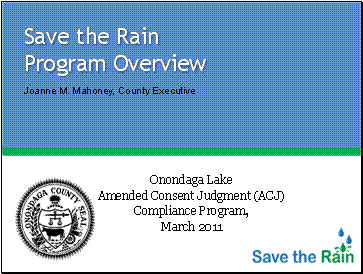 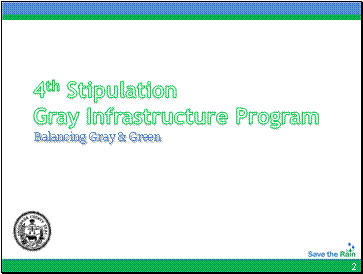
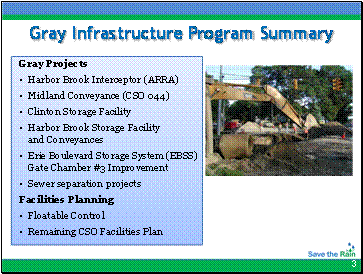 
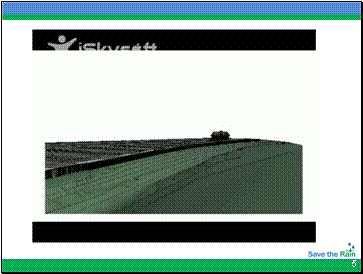 
 
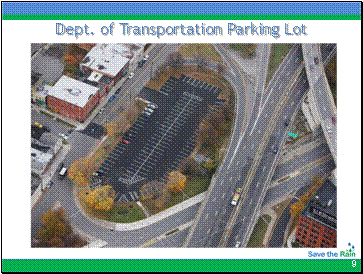 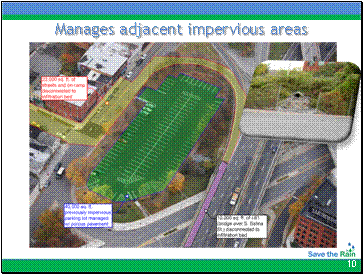
Used 2 lift paving approach ATPB + porous
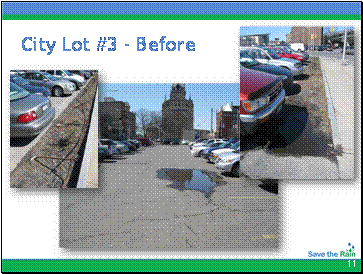 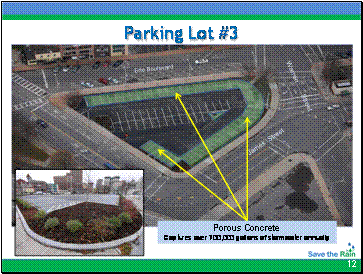
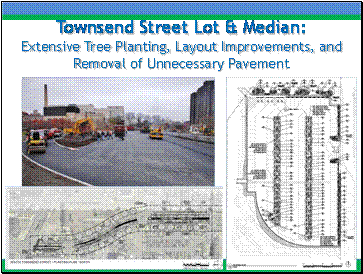
For Pearl, Lot 3, and Townsend: bids came in significantly under cost estimate. Townsend median - decided not to do full tree planting as originally envisioned because of the possibility of a future road reconfiguration (road diet). Lot improvements expected to increase lease earnings from private operator.Need for salt tolerant trees that also can be planted in the fall and suited for bioswale/tree trenches.
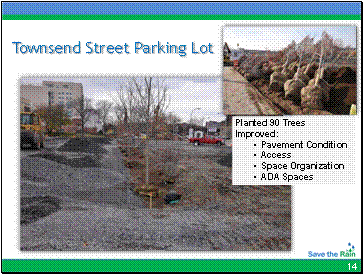
90 Trees, improved access, organization, and provided ADA spaces.

LIDAR-based analysis
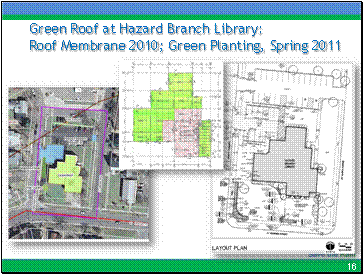
Structural analysis revealed about 2/3 of roof had sufficient structural capacity to support green roof with no reinforcing. Switching to green roof membrane from the original conventional roof was no cost.
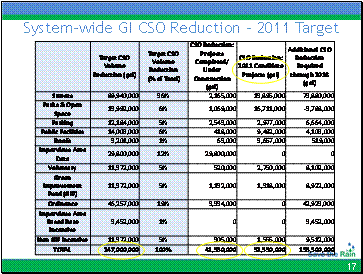 
60,000 sq ft
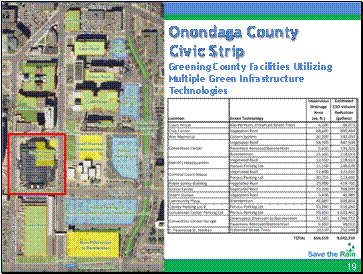 
 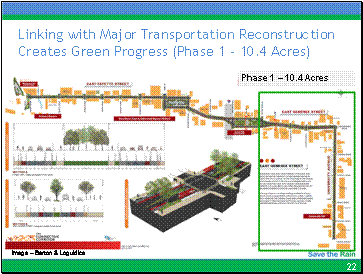
Connective Corridor, saves earth moving costs
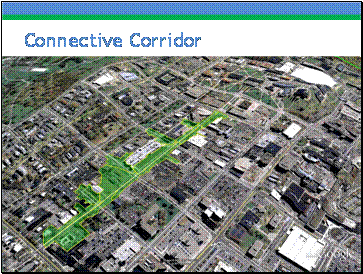 
 
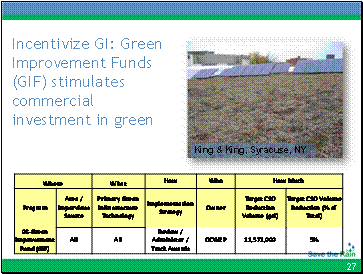 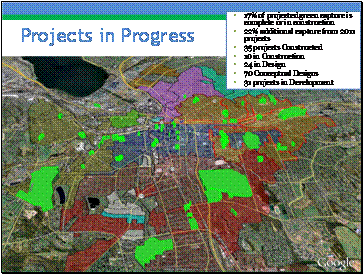
 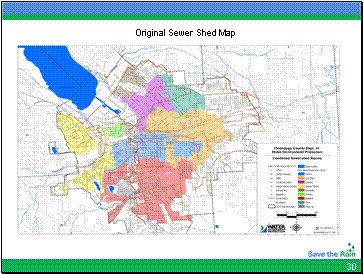
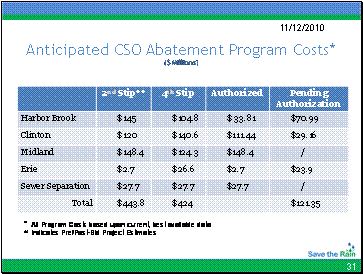 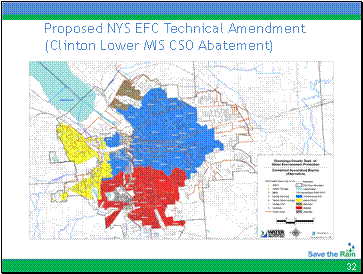
 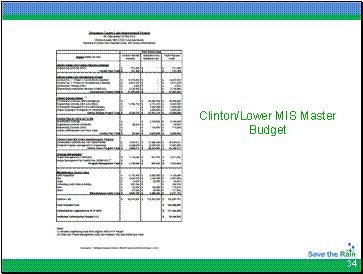 F F
Copies of budgets for Midland, Harbor Brook, and Clinton/Lower MIS attached.
Gray Projects – Mr. Kukenberger
-
Harbor Brook interceptor – under construction now
-
CSO 044 – bid awarded to JJ Lane – construction starting later this month
-
Clinton Storage Facility – in review now; will be advertised in early April
-
Harbor Brook Storage Facility – in design; will be advertised later this summer
-
Erie Blvd. Storage System Gate Chamber improvements – small, ongoing – adjust gates and measure results
-
Sewer Separation projects – CSO 022 (downtown near Dinosaur BBQue), and 045 (southwest community)
-
Facilities Planning – Floatation Cont. and remaining CSO facilities plan are complete – comments back from DEC and have responded to comments
-
Clinton Storage Project:
-
Designed towards architectural features of Armory Square
-
Small building designed to look like a train station
-
3 horizontal tunnels under trolley lot – 6 million gallons of storage total
-
Building with all odor control pumps, electrical equip and operation facilities
-
Green Components: rainwater from roof and site for flushing – catch and reuse rainwater, reduces cost of County for second flushing (first flushing typically done with CSO water); drainage swales and rain garden features
In answer to Chairman Corbett; Mr. Kukenberger said that the parking lot is not porous pavement, as that is where the stormwater will be captured.
In answer to Chairman Rhinehart, Mr. Kukenberger reported that the design is complete, being reviewed by the County; now in review by DEC. The engineering and design cost was included in the budget. Mr. Millea noted that the total engineer and services budget for the storage project is $8.5 million; the current contract is $5.7 million, which would include RTF and storage design.
Green: Matt Marko, CH2M Hill
(see Green Infrastructure Project List – attachment b)
-
Goal to capture 6% of the 95% mandated by courts
-
470 acres of green infrastructure to be installed throughout the sewer shed; approx. 250 million gallons of volume by 2018
-
Completed: Lot 21 (old Farmers Market Lot), Clinton/Washington St.; green infrastructure in center, captures 1” + rainfall
-
Completed: Pearl St. parking lot (owned by State DOT, managed by City), pick up run off from Rt. 81 * onramp, and parking lot itself
-
Completed: City Lot 3 (north of City hall) standard asphalt graded so runoff is sloped to periphery were their is porous concrete; bio retention and rain barrels around periphery
-
Townsend Lot B (East of Everson) – started last year; median work with green space starts in April; capture is slighted less than 1 million gallons
-
Flat rooftops and green roofs – many opportunities; downtown district has a number of flat roof
-
Hazard Library roof – spring 2011 – 6,000 sq ft green roof
-
Elephant exhibit, zoo – Summer 2011 – 6,000 sq. ft green roof
-
Signature projects:
-
Green roof at Oncenter. 60,000 sq. ft; out for advertisement; bids due in a week; green street at Harrison Street space between Conv. Center and War Memorial, surface lot at OnCenter, diverting roof leaders from parking garage, mtg. with DOT regarding pavement removal below the garage; Townsend median, working on cistern to address runoff from the War Memorial roof
-
Received $3 million in EPA funding – reimbursement grant
-
Target 50 green projects for 2011
-
Goal is at least 27 million gallons/year – doing biggest and best projects first and targeting 40 million gallons in 2011
Mr. Buckel referred to parking lot projects and asked where the water goes. Mr. Marko said that it can go into the ground and it becomes part of the water table, or it can be caught in bio retention and held until it is absorbed by trees and plants, or evaporates into the air. Mr. Buckel said that a concern for a building owner is, will it cause flooding on other property. Mr. Marko said that they pay attention to it; regarding groundwater mounding – with all the impervious areas, they have disrupted the natural system, it goes in the sewer and is taken away. In many cases it doesn’t always work that way, and they do create drainage problems. By re-naturalizing these systems, it should help in the long run. The hope is that by and large the system will be improved overtime as they naturalize the landscape. Mr. Buckel asked if there is a sense of the water table; have the risks been minimized in regard to a contaminated area. Mr. Marko said that they know as much as where they have data – in some cases they have a lot of data. In others, they have very little data. An infiltration test is done for every project; allows them to understand how quickly the soil accepts the water being added to it, which feeds into whether they go with an infiltration system or a bio retention system. An environmental site assessment phase one is done for each project to alert them to environmental issues that may exist. Chairman Corbett noted that when the parking lot site was looked at for a future hotel, there were one or two gas stations there at one time; the depth of investigation and engineering that goes into these projects includes a tremendous amount of work.
Chairman Rhinehart asked if the Oncenter needs a new roof. Mr. Millea said that that it is towards the end of its useful life; it has 3 years left. Chairman Rhinehart asked about the Justice Center. Mr. Marko said that they are in the final phases of structural analysis for the facility; structural analysis will tell them how intensive the green roof can be. Before they started these projects, they worked with Facilities Management on all county properties with flat roofs. An assessment for not just condition, but also feasibility for green roofs, was done. Chairman Rhinehart said that some are concern if there is random picking of places that qualify for green but don’t need a new roof – the taxpayers would love to hear that it needs a new roof. Mr. Marko said that they are analyzed significantly; some projects will be deferred until 2015 or 2016 because they have another 5 good years of life.
Chairman Rhinehart said that last month he asked to be provided with the criteria for private property projects, as there are number on the list. He feels this committee would like to see what criterion is used; which private properties in the city are going to get this benefit and why they were selected. For the record, Chairman Rhinehart noted that all of the 81 projects are in the city; none on the list are outside of the city. Mr. Millea said that is because the ACJ territory is defined in the consent judgment as being the particular sewer shed. A draft resolution will be presented to the committee today, which will be brought forward next month, to expand the Save the Rain program beyond the ACJ footprint. Chairman Rhinehart asked if the City will accept porous pavement for sidewalks. Mr. Marko said that in 2010 a sidewalk was installed on Grand Ave., used as a test case for aesthetics and durability. Maybe by late 2011 they can talk about relaxing the City’s standard and moving forward with a whole new paragon for sidewalks.
Mr. Millea said that he will provide a briefing on the green improvement fund; will provide a full review of the process, who has applied and who has gotten projects. There is a debate amongst the policy committee on how to improve the review process and increase the return on investment by thinking differently as they reward them. Chairman Rhinehart said that this Committee may want to have a say in that on behalf of the taxpayers; he is looking forward to getting that information. Mr. Millea said that they also want the website to be transparent – putting up who has applied, what they received, what the project is, cost, public or private, etc. Chairman Rhinehart said that it needs to be – this is taxpayer funds investing in private properties.
Chairman Corbett said that every time one of these projects are done, it gives a leg up as a community as to what will likely have to be done on the MS4s.
Mr. Millea distributed a resolution entitled Amending the 2011 County Budget in Order to Provide $1.2 Million in Funding from the Department of Water Environment Projection to Establish and Promote the Use of Green Infrastructure Applications Throughout Onondaga County Under the Banner of Onondaga County’s “Save the Rain” Program, which will be brought forward at the April committee meeting.
4. WEP:
a. A Resolution Approving the Increased Cost of Certain Improvements for CSO Improvements for the Onondaga County Sanitary District
b. A Resolution Authorizing the Issuance of an Additional $54,058,000 Bonds of the County of Onondaga New York to Pay the Increased Cost Of Additional Gray and Green Infrastructure to Abate Combined Sewer Overflows in and for the Onondaga County Sanitary District, Intended to Enable the County to Comply with Requirements Set Forth in the Amended Consent Judgment in Connection with the Settlement of Atlantic States Legal Foundation, Inc. et al v. County of Onondaga, et al
Mr. Millea said that the Harbor Brook discussion, in coming in for $70 million, was no small ask. It is also recognized that coming in and asking for an additional $54 million, on top of that, is also no small ask. They feel that it would be a cost of $120 million in total as of November. They have tried to create efficiencies, internally within the County, as far as coming forward with one final bond resolution. This budget is the final budget to get through 2018 to comply with ACJ. This consolidated 8 sewer sheds into 4 sewer sheds (see attached budgets – attachement a). On April 5th they will ask for the passage of the Harbor Brook resolution, and $54 million for Clinton and lower MIS. The resolution is for a much larger area than Clinton was originally known to be (map on file with Clerk). This is a consolidation of funding, putting it into one package to be considered and ultimately making it easier to have dialogue with EFC as they go forward. There are some projections that the EFC financing could save the County up to $31 million in avoided interest costs. They believe that this is the final ask to get them through the ACJ compliance program.
Chairman Corbett said that there was a lot of consideration to bundling these projects, rather than them coming back and asking for $10 million here and another $5 million there. They have made their best effort to put this together as a package; bonding will be done in one resolution. Just because there is the authorization to bond, if it doesn’t cost that much, they don’t have to spend that much. He appreciates the effort of the whole group.
Chairman Corbett said that he has been working with the Comptroller’s office on the past work of the ACJ from day one up until when it ran out. The Comptroller’s office will be issuing a summary of what they feel are the pros and cons. The full report is still being compiled. Mr. Britt added that he believes the Comptroller is looking to issue the summary at the end of March; some information is still being compiled. Chairman Corbett said that the Comptroller’s office has had a challenge of trying to hit a moving target, because what was originally put out there for work, has constantly changed – now on the 4th stipulation.
Mr. Kukenberger said that they were asked to do an evaluation for the Wicks Law; the evaluation has been completed; are doing peer review now internally. They evaluated the use of Wicks Law, or avoidance of it, for two projects: Clinton Storage project and Harbor Brook Storage project – the two big remaining projects that would fall under the Wicks Law. A recommendation will go to the County Executive. In 2008 legislation was passed that allowed a municipality to be exempt from Wicks Law if there is a PLA. It is predicting whether or not there are benefits and cost savings of avoiding Wicks Law. IF there are cost savings, it will be up to the County Executive to decide if there is enough savings to move forward with a PLA. Mr. Millea said that the cost of the analysis was approximately $15,000.
A motion was made by Mrs. Ervin to approve item 4a, seconded by Mr. Buckel; passed unanimously. MOTION CARRIED.
A motion was made by Chairman Corbett to approve item 4b.
Mr. Buckel asked if this is different than the prior resolution. Chairman Corbett said that this item had not gone through this committee previously; it will also go to Ways and Means. This is the bonding for the bundling of the 4 sewer sheds.
Mr. Buckel seconded the motion. AYES: 2 (Corbett, Ervin); NOES: 0; ABSTENTIONS: 1 (Buckel). MOTION CARRIED.
The meeting was adjourned at 11:05 a.m.
Respectfully submitted,
DEBORAH L. MATURO, CLERK
Onondaga County Legislature
* * *
COUNTY FACILITIES COMMITTEE MINUTES - MARCH 10, 2011
KATHLEEN RAPP, CHAIR
MEMBERS PRESENT: Mr. Dougherty, Mr. Kinne, Mr. Masterpole
MEMBERS ABSENT: Mr. Lesniak, Mrs. Tassone
ALSO PRESENT: Mr. Stanczyk, see attached list
Chair Rapp called the meeting to order at 9:01 a.m. A motion was made by Mr. Masterpole, seconded by Mr. Dougherty to waive the reading and approve the minutes of the proceedings of the previous committee meeting; MOTION CARRIED.
1. ONONDAGA COUNTY PUBLIC LIBRARY: Sally Carmer, Fiscal Officer and Facilities Manager
a. Amending the 2011 County Budget to Accept New York State Division of Library Development Funds for the Onondaga County Public Library, and Authorizing the County Executive to Enter into Contracts to Implement this Resolution ($20,106)
Ms. Carmer reported:
- This is year two of a two year grant for the Opportunity Online Broadband Grant through New York State
- For Baldwinsville Public Library, Northern Onondaga Public Library and Salina Free Library
- Enables the above libraries to upgrade their current internet capacity and provides training for using broadband
- Enables them to take advantage of the E-Rate Program including training – Federal Telecommunications Act Program which enables libraries to receive a discount on the telecommunications services
Mr. Masterpole asked about the status of year one. Ms. Carmer said it is the same three libraries as year one.
A motion was made by Mr. Masterpole to approve this item.
Mr. Dougherty wanted to know what the training entails. Ms. Carmer explained it is how best to use broadband and how to take advantage of increased broadband, but most importantly the training focuses on the E-Rate Program where the libraries can be reimbursed for telecommunications. Mr. Dougherty implied that the libraries have broadband currently. Ms. Carmer agreed and said the reason the three libraries were picked is because the funding source was the Bill and Melinda Gates Foundation, which a few years ago sent software enabling each library to survey what their current equipment and usage is. Currently the three libraries mentioned are most in need of an upgrade.
Mr. Dougherty seconded the motion to approve this item.
Mr. Masterpole inquired if the E-Rate has to be Voice over IP. Ms. Carmen said no and explained there are five different categories. Onondaga County Public Libraries brings in over $100,000 a year in E-Rate reimbursement for telecommunications.
Passed unanimously; MOTION CARRIED.
2. TRANSPORTATION: Brian Donnelly, Commissioner
a. Amending the 2011 County Budget in the Road Maintenance and Road Machinery Funds to Increase Appropriations and Estimated Revenues in Order to Maintain a Balanced Budget ($361,283)
Mr. Donnelly reported:
Chair Rapp asked if the $1 million was cumulative over many years. Mr. Donnelly replied it was the 2010 year.
Mr. Donnelly continued:
- Attachment details where the fund balance is coming from
- Asking for $489,000 to cover the shortfall
- Fund balance is divided by Highway and Road Machinery
- Amounts in the column are the surplus amounts, which remained in the account at the close of the year
- Highway division is $775,000 - $158,000 saved in overtime and small savings in other categories; interdepartmental charges significant including indirect costs totaling $300,000 – indirect charges is the amount given by the comptroller’s office; employee benefits surplus based on early retirement program offered; miscellaneous interdepartmental charges are remainder; slight increase in revenue on automobile usage tax
Chair Rapp asked why the indirect charges are so off. Mr. Donnelly explained the comptroller’s office supplies the figure and bases it off of 2008 and 2009. Chair Rapp said it would make sense if it were consistent year to year as it is not benefits or personnel related. Mr. Donnelly responded that it is strictly indirect costs that are not directly billed to the departments. Mr. Rowley interjected saying the indirect costs are costs allocated by the Comptroller throughout the departments to ensure the budget department is reimbursed correctly for the departments charged for state aid. It is part of the single audit that occurs every year done by an outside consultant who uses data with a two year lag.
Mr. Donnelly continued:
- Road Machinery
- Supplies is fuel – actual average cost verses the budgeted cost resulted in a surplus of $151,000
- Utilities and outside repairs were both lower
- Revenues – higher than budgeted for the sale of scrap, auction of equipment and fuel sales to outside agencies including the Sheriff’s Department
- Combined total with highway and road machinery equals $1,092,000
- Asking to take $489,000 from the DOT Fund Balance and use that to offset the projected shortfall
Mr. Dougherty asked if that leaves $280,000 - $300,000. Mr. Donnelly responded it will leave approximately $500,000 in the DOT fund balance. Chair Rapp clarified that around $200,000 would come from the 570 account for the towns. Mr. Donnelly said $266,000 will be transferred within the existing budget.
A motion was made by Mr. Masterpole, seconded by Mr. Dougherty, to approve this item. Passed unanimously; MOTION CARRIED.
Mr. Masterpole stated that during budget DOT discussed needing a replacement for a wrecker and it was denied or deferred at the time. He said Monday he witnessed a City DPW truck slide off the road and a company such as Meyer’s had a wrecker they brought out to haul out the City truck. He asked if he could make a suggestion to have a discussion with the City to have a joint wrecker since the City does not own one and DOT needs one to replace another. He said it may not work, if one uses it more than the other, or possibly it will. Mr. Donnelly responded it would make sense to explore it. He is unsure what the City’s needs are but will talk to the City to get more information on where they stand and if it is something they would be willing to partner on. Mr. Masterpole said the County may want to split the cost with the City or create a renter’s agreement with the City.
Chair Rapp thought that currently the towns lease the wrecker from the County so it would make sense if the City were to do the same thing. Mr. Donnelly responded that the City could but has never asked for services. Towns will sometimes ask and the County will help if able. It is not set up as a direct share or rental with towns but the county will help in emergency situations for the towns and villages.
Mr. Masterpole closed by saying it was the only City truck that was working at the time, and the City definitely used an outside vendor such as Meyer’s. Mr. Donnelly responded that the only two private services he is aware of are Meyer’s and Big Red. He will reach out to the City and see what the need is.
3. Requesting Elected County Officials to List and Identify all County-Owned Take-Home Vehicles and to Take Steps to Reduce the Number of Such Vehicles by Half (Sponsored by Mr. Stanczyk) - Referred from March 1, 2011 Session: Mark Stanczyk, Legislator
Mr. Stanczyk reported:
- This item was sent to committee by the Chairman
- Asking for an account from the elected officials of the take home vehicles
- Make sure they understand it is important for the Legislature to have an accounting which currently the Legislature does not
Chair Rapp was under the impression the Legislature asked for this information at budget time. Mr. Stanczyk replied he was sure the Legislature did not receive it. Chair Rapp clarified the Legislature asked but did not receive the information.
Mr. Stanczyk continued:
Chair Rapp responded the information should be collected before deeming the departments to budget for half the amount. She asked where this figure came from. Mr. Stanczyk replied there are a lot of people that need jobs, want jobs, have half jobs or no jobs. He heard statistics stating more than 80% of the vehicles in the Sheriff’s Department that are take home have never had a call for service - they are being used for personal reasons. The Sheriff has a take home vehicle used to go to his camp outside Onondaga County, which is not right. There should be an accounting of these things so it can be shown to others that it has to stop.
Mr. Dougherty asked if Mr. Stanczyk would be willing to separate the request for information and the amount given to be half. Mr. Stanczyk had no issue with separating the two items. He would like the formal request to go out and if the request is not met, the Legislature will have the opportunity to hack into the departments. He reiterated he will pull the items apart. Chair Rapp replied it would be better to have the information first because it may mean the amount will be reduced by more than half. Mr. Stanczyk would like the information to be able to ask why certain people need to have a take home vehicle. Mr. Kinne stated a department may come in and say the amount is not 50% but could be 45% or 40% so the adjustment can be made. Mr. Stanczyk responded it is a request, and there is information on the extent of the problem. He asked if this formal request is not met, what should the Legislature do. Mr. Dougherty replied a second resolution should be written stating the Legislature will take steps to product the numbers.
Chair Rapp asked if there is a date for when the numbers are to be in. Mr. Stanczyk replied April ’11 Ways and Means week; 6-8 weeks. Chair Rapp responded that is plenty of time to count the vehicles.
Mr. Stanczyk requested the resolution be sent to county officials if it is passed today knowing it will be sent to the April session.
Chair Rapp replied that gives plenty of time to get the numbers in.
Mr. Stanczyk made a motion to amend the resolution by taking out the words “by half” in the title and first RESOLVE clause.
A motion was made by Mr. Masterpole, seconded by John Dougherty, to approve this item as amended. Passed unanimously; MOTION CARRIED.
Mr. Stanczyk stated if there were a lineup of county employees, every third employee would have a cell phone that is paid for by Onondaga County. There are over 1200 cell phones currently. He would like someone to begin asking questions to justify this amount. Chair Rapp responded that at the next committee, Planning and Economic Development, She will have a discussion on this topic. Mr. Stanczyk inquired if the information was provided or if the committee will be having the conversation without the information. He is suggesting to do a resolution similar to the one they just discussed reference take home vehicles.
Mr. Rhinehart suggested getting rid of the land lines and giving everyone a cell phone instead and save the $2 million. He stated the conversation should be all encompassing instead of targeting one topic. Mr. Stanczyk replied that he is not sure if there is a distinction between the uses of the cell phone for county business verses private business. He is questioning if the county employees who have a cell phone, have a personal cell phone in one pocket and a county cell phone in the other, or if they only have the county paid cell phone. If the County were to do all cell phones, what would be the distinction between county use and private use?
Chair Rapp asked if there is an audit on this subject. Mr. Rowley responded there is an outside consultant who is looking at the cell phone world at the county. Not only are they looking at who has what cell phone but also what plan they are on. This agency is going to help with policies and make suggestions with plans to save money. Plans currently existing are grandfathered plans so they do save money by being less than a current plan on the market today. Mr. Stanczyk asked doesn’t it seem excessive to have 1200 cell phones that the county pays for. Mr. Rowley said he will not make that judgment. He responded saying each department has justification as to why they need cell phones. Mr. Stanczyk asked what the percentage is of county use done on the cell phones. Mr. Rowley explained the reports are being done and will hopefully shed light on the subject.
The meeting was adjourned at 9:27 a.m.
Respectfully submitted,
Jamie M. McNamara, Assistant Clerk
Onondaga County Legislature
* * *
PLANNING & ECONOMIC DEVELOPMENT COMMITTEE MINUTES – MARCH 10, 2011
KATHLEEN RAPP, CHAIR
MEMBERS PRESENT: Mr. Dougherty, Mr. Stanczyk, Ms. Williams
ALSO PRESENT: Mr. Rhinehart, Mr. Meyer and see attached list
Chair Rapp called the meeting to order at 10:30 a.m. A motion was made by Ms. Williams, seconded by Mr. Dougherty to waive the reading and approve the minutes of the proceedings of the previous committee meeting. Motion CARRIED.
1. SYRACUSE CONVENTIONS AND VISITORS BUREAU: David Holder, President; Terri Toennies, Oncenter President and CEO
a. Amending the 2011 County Budget to Provide Funding to the Syracuse Conventions and Visitors Bureau and the Oncenter Management Corporation to Pay Expenses Associated with the United States Bowling Congress Women’s Championship Event (Sponsored by Mr. Lesniak)
- Additional expenses not foreseen as part of the budget process
- Move in, load in and signage cost
- Leave behind just how welcoming Syracuse is, want to attract more business
- Hardware will be used for other events; heavy duty brackets
Mr. Stanczyk questioned the warehouse cost at $72,000. Ms. Toennies responded that the event ended in July. All the hardware and bowling balls were shipped to us at that time. The $72,000 and $22,500 were already in the budget and are not part of this additional fund request. The spreadsheet has been revised for clarification.
Unbudgeted Expenses for US Bowling Congress Women's Championship |
|
|
|
|
|
|
Load-In/Load-out costs (February 21st to April 7th / July 11 to August 8) |
|
|
Ancillary Warehouse Costs |
|
|
|
|
$9,455.04 |
|
|
|
|
|
|
Tent for storage in open lot |
|
|
|
|
$10,000 |
|
|
|
|
|
|
Parking - |
|
|
|
|
$20,190.00 |
est. lot - 65 spaces x $6 x 46 days |
|
|
|
|
$ 17,940.00 |
est garage - 25 spaces x $6 x15 days |
|
|
|
|
$ 2,250.00 |
|
|
|
|
|
|
Alliance Bank Parking |
|
|
|
|
In-kind |
|
Using Alliance Bank Stadium spaces for trucks |
|
|
|
|
|
|
|
Alliance Bank Parking dispatcher |
|
|
|
|
|
74 hrs @ $8.50/ hr |
|
|
|
|
$629.00 |
|
|
|
|
|
|
Load-in Subtotal |
………….. |
………….. |
………….. |
…………. |
$40,274.04 |
|
|
|
|
|
|
Promotion & Community Outreach (March to August) |
|
|
|
Street Pole Brackets & Banners |
|
|
|
|
$16,170.00 |
55 street pole brackets x $130 each |
|
|
|
|
7150 |
110 banners x $82 each |
|
|
|
|
9020 |
|
|
|
|
|
|
Billboards |
|
|
|
|
$12,850.00 |
4 flights x $3075 per flight on I-81 S at Genant Dr. (+ $550 for layout) |
|
|
|
|
|
|
|
|
Promotion Subtotal |
………….. |
………….. |
………….. |
…………. |
$29,020.00 |
|
|
|
|
|
|
Build-out Costs |
|
|
|
|
|
Riser Rental |
|
|
|
|
$48,668.00 |
Includes Labor and Material for construction and 6 month rental |
|
|
|
1 - 32' x 11' x 4' with handrail |
|
|
|
|
|
1 - 112' x 13' x 4' with handrail |
|
|
|
|
|
1 - 104' x 11' x 4' with handrail |
|
|
|
|
|
|
|
|
|
|
|
Build-out Subtotal |
………….. |
………….. |
………….. |
…………. |
$48,668.00 |
|
|
|
|
|
|
TOTAL REQUEST |
…….. |
……… |
……… |
…….. |
$117,962.04 |
In answer to Mr. Stanczyk, Ms. Toennies stated the parking is not true revenue. They are using 100 parking spaces for the load in. In answer to Mr. Stanczyk, Ms. Toennies stated that the parking fees would be paid to the Oncenter. Chair Rapp stated this would be ROT money coming to the Oncenter to replace funds that would have been generated by parking fees. Ms. Toennies stated it was for displaced revenues. In answer to Chair Rapp, Ms. Toennies confirmed this could be considered in-kind. A conversation would need to take place with the City and County because the City gets a split from the garage and the County gets a split of the lot parking revenues. Mr. Stanczyk stated if there is no revenue, there is nothing to share. Ms. Toennies stated there is a value to it; space that was used without payment.
In answer to Mr. Stanczyk, Ms. Toennies stated they are renting risers for bleacher style seating. Initially they were going to make use of our stages and banquet chairs however it was not something that they were able to work with. The company gave us a really good price. The initial price was $110,000, negotiated down to $48,000 for 4 months of rental. The risers seat 300 and will be used for spectator viewing. Mr. Dougherty questioned the price. Ms. Toennies responded that they are building actual scaffolding; it’s not just rolling risers. The bids are available if you would like to view them. In answer to Mr. Stanczyk, Ms. Toennies stated that she did not believe it was something that could be built and then sold after the event.
Samples of the signage were reviewed by the committee.
- 32 street pole banners will be at the Oncenter and the rest will be scattered around the community (12 Armory Square, 13 Crouse-Marshall District, 10 Genesee Street, 5 Regional Market, 5 Plank Road, 11 airport)
- Crunch has shown interest in renting two brackets on each side of the building after this event
- Other signage around town at Carousel Center and airport, “We Love Bowlers” banner
Mr. Stanczyk questioned if this would be the last fund request for this event. Ms. Toennies and Mr. Holder confirmed that this should be their last request.
In answer to Chair Rapp, Mr. Holder stated the total cost will be about $1 million. The estimated ROT revenue will be around $450,000 and sales tax should be $1.5 million. Total generated revenue for local businesses should be $40 million. Mr. Stanczyk questioned if the $1.5 million in sales tax was total sales tax with Onondaga County getting $750,000. Chair Rapp stated that she believes the $1.5 million is Onondaga County’s share of the estimated tax revenues. Mr. Holder stated he would verify the information and report back to the committee.
- Largest participatory sporting event in the country; very highly rated
- Precursor to some smaller scale bowling events that they are trying to obtain; would love to bring this back also
- Sets the stage for other month long sporting events; Onondaga County can support this type of event, perfect fit for our community
A motion was made by Ms. Williams, seconded by Mr. Dougherty to approve this item.
- Banners will be installed by Graphic Warehouse, included in the price of the banner
- Permission has been obtained for installation on light poles
Passed unanimously; MOTION CARRIED.
2. INFORMATION TECHNOLOGY: Ken Beam, Chief Information Officer; Bill Fisher, Deputy County Executive
a. Overview of Reorganization
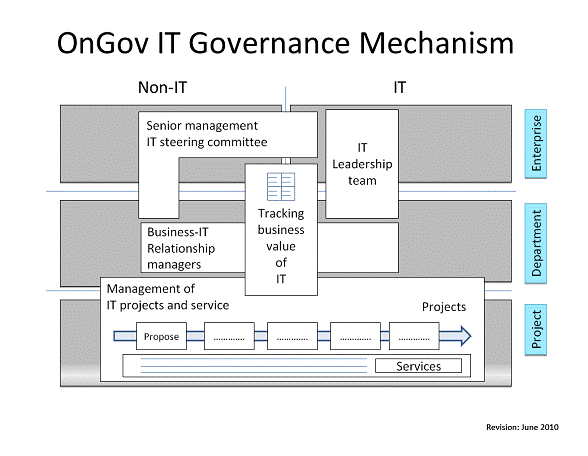
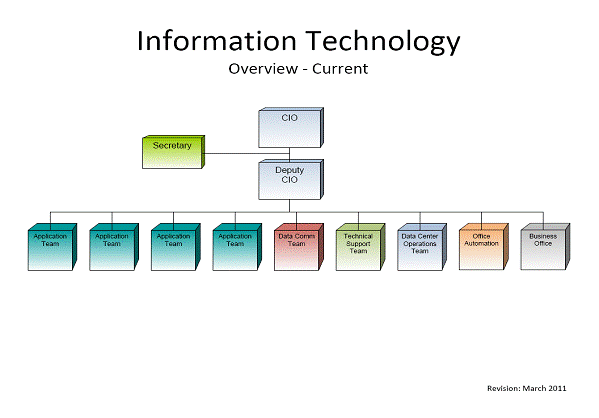
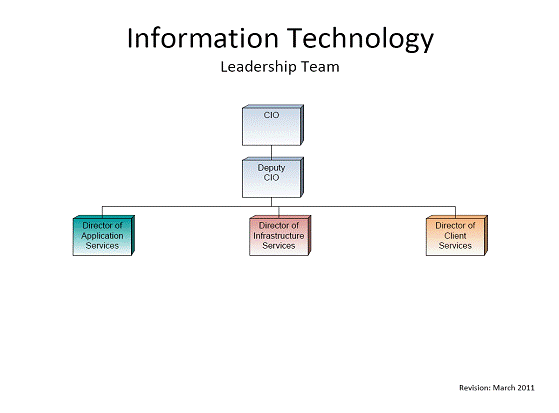
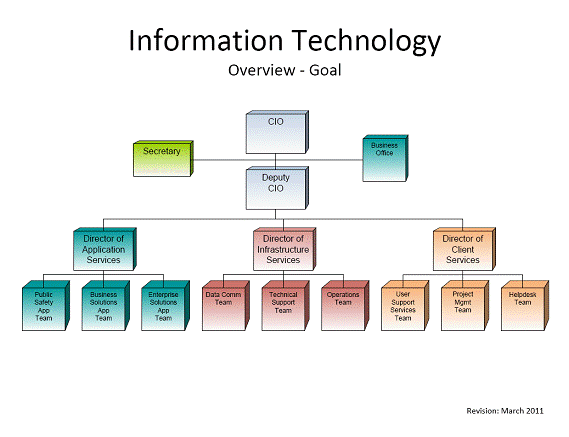
- Biggest change to IT governance is the Stirring Committee
- Stirring committee chaired by Mr. Fisher, consists of Mr. Millea, Mr. Rowley, Ms. Rooney, Mr. Seitz, Mr. Troiano, Mr. Beam, and Ms. Clark
- Bulk of Stirring Committee comes from the business side of the house
- Committee will set policies, establish priorities, make departments compete against one another for scarce resources
- Expansion of IT Leadership team
Chair Rapp questioned if adding people to the leadership team would violate any management or union worker regulations. Mr. Fisher responded that you cannot have people performing work out of their title. They will be working with the Personnel department to change the titles and come up with job descriptions that match the work required. Chair Rapp questioned if the expansion would include management or union personnel. Mr. Fisher stated that the details will be coming over with the personnel resolution, they do not have one here today.
- New format will provide better control of IT projects, streamline services to departments, keep cost in line
- Currently very confusing for departments to know whom they need to contact, delays projects and increases costs
- Departments will contact one of two people with requests; Director of Application Services or Director of Client Services
In answer to Mr. Dougherty, Mr. Beam stated that calls are actually made to the help desk. It would have been messy to put all the staff on this graph. Mr. Dougherty asked for an example.
- Printer problem called into help desk
- 1 of 4 computer tech specialists will determine if it is an application or hardware issue; problem handed off to the correct person
- Tech will call to see to if you are available, come over repair problem and make sure you are satisfied
Mr. Dougherty asked how larger issues would be handled such as a department head needing a program written.
- Department head would deal with Director of Application Services
- Director would go to the Deputy CIO, they will to see if there is another application in use that provides what is needed or could be enhanced to do so.
Mr. Fisher stated that one of the problems they currently have, is that they don’t have a single IT Management System. There is a variety of them.
- Working to migrate to a single IT Service Management Solution with all IT staff on the same system
- Reorganization is required in order to make the system run properly
- Currently departments contact the manager assigned to their department (1 of 9 people)
- Manager then enters request into a help desk system that only they have access to
- Next it must be determined which one of the groups the problem should go to
- Once it goes to the group it needs to be determined who in the group gets assigned to the project
In answer to Mr. Stanczyk, Mr. Beam stated the Director of Client Services would be a new hire. They do not currently have this skill set in place. The other two Director positions would be advancements. Positions will not be backfilled and will be abolished upon complication of their probationary period.
In answer to Mr. Stanczyk, Mr. Beam stated that the Directors should not be doing task. They should have enough cross trained staff underneath them; they will be in charge of managing all the tasks.
Mr. Stanczyk stated that in these times organizations are going for less management rather than more. Mr. Beam responded that they were decreasing. Mr. Stanczyk stated that all the current managers were staying on staff; none were being demoted. Mr. Beam stated they could not demote anyone. There is a whole plan that he will be bringing to them in April. Mr. Dougherty questioned how it was determined what gets done; there are too many peers. Mr. Stanczyk stated his only concern is that we were not creating more positions. Mr. Fisher stated the details will be coming in April.
Mr. Fisher stated they will be asking that money be moved out of the contingency account. Mr. Stanczyk stated this is the first part of the demonstration, for the fourth time.
Chair Rapp stated that she counts 12 positions on the current overview and 15 positions on the overview goal. She questioned how this does not create new positions. Mr. Beam stated to keep in mind, these are teams not positions. They will come back with the full overview. Mr. Beam confirmed that the only new body would be the Director of Client Services.
In answer to Ms. Williams, Mr. Fisher stated that this plan was in the 2011 proposed budget and was removed via the Ways and Means Committee. They came over in the following month and asked for the Early Retirement Incentive (ERI) personnel resolution and the reorganizational resolution to be passed together. The reorganizational portion was pulled out and never made it to the floor for a vote. We came back again, with the ERI portion and it was passed. We are now back with a better explanation of the reorganization.
- No immediate savings; do not have a long term projection
- Running 2 different systems now; once the mainframe is turned off we will no longer need those personnel
Chair Rapp summarized and Mr. Beam confirmed that there will be three different departments, everyone will know where to go, they will figure out how to get everyone in the positions with the union, and stay within the budget.
b. PeopleSoft Implementation Plan
Mr. Beam presented the committee with a handout on the PeopleSoft plan (on file with the Clerk).
Platform & Infrastructure (2011)
Phase: Maintain / Manage
Current Status: On time, On Budget, No outstanding issues
User Education
Phase: Core Team Indoctrination
Current Status: Late, Workshop scheduling well behind schedule, Issue: Insufficient participation from Oracle
Financial System and Budgeting
Phase: Initiation / Requirements Definition
Current Status: On time, On Budget, Risk: Incorporation of other entities as part of purchasing consolidation effort
Human Resources, Benefits, and Payroll (2012-2013)
Phase: (does not officially begin until late 2011) Initiation
Current Status: On time, On Budget, No outstanding issues
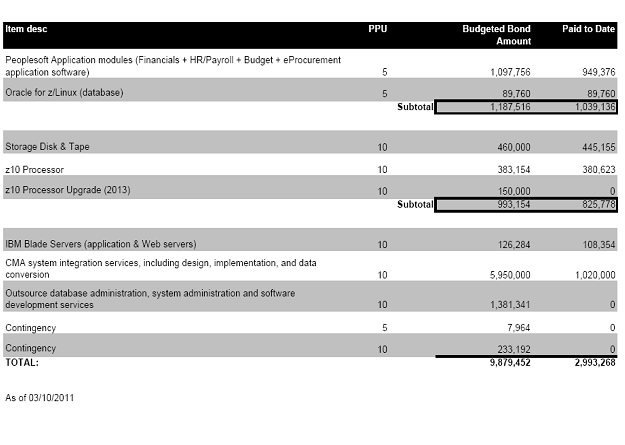
- Steering Committee approved the recommendation to move away from the mainframe applications
- Move to database technology from Oracle
- Decision was made at the executive level, project is very expensive and without executive support very good chance the project would fail
- In addition to the software, need to make sure that the organization is ready for the change
- Prepare with training, early involvement with a number of departments
- Multi year process to install software
- Business processes that need changing will be completed prior to the software arrival
- 4 components to the project, listed on the left side of the graph by color
- Currently working on the financial systems and training related
-
We are in departments figuring out their work processes and flow, should be done within the next 30 days, once completed we can begin to configure the application
- We have to be up and live by October 2011; mainframe will stay in place for another 2.5 yrs
- Will take about 36 months to complete project, end of mainframe lease coincides with the PeopleSoft application being fully live
-
As we progress the amount of applications run on the mainframe will decrease; funds paid to IBM will decrease, currently over $1 million per year, equipment and MIPS (millions of instructions per second) are leased
- Migrating to hardware that we will own, software that we license and pay a small yearly maintenance fee
In answer to Mr. Dougherty, Mr. Beam stated that we do not currently have anyone working on the system. Departments have been fully engaged in preparing for this project. There is a high level of excitement for employees. They want to move to something more modern. The people doing the work are sitting alongside the migration staff to make sure that the information migrated has the correct structure. Mr. Maturo is building the system in a manner that is consistent with what the Comptroller’s office needs to process their work; working very closely with the PeopleSoft migration staff. In answer to Chair Rapp, Mr. Beam stated they are currently working with high level staff only. Chair Rapp asked if the high level staff would then be training their own staff. Mr. Beams stated they are planning on training the trainer; do not have that in place at this time.
- Currently focusing on the financials, workshops and knowledge transfer
- Jan. 2012 the new financial system will be live; end user training will begin
- Training will come in just ahead of each system becoming live
- Grid Control - training for the technical staff completed
- Hyperion - budget planning for public sector training completed, included Comptroller, Management & Budget, IT
- Grants training completed
- E Pro - purchasing module training is scheduled for March 23
- Training is not as detailed as it should be; additional trainers need to be obtained
- Demo site is up and running for people to get a feel of the program
- Business processes don’t match the new programs; will see revisions in the 2012 and 2013 Budget
Ex: each department will not need their own payroll clerk – 1 clerk may handle 10 depts.
- By 2014 -2015 they will be able to provide salary savings numbers, work will be more streamlined unsure how it will all work out at this time
Chair Rapp stated that we should see dramatic improvements for $10 million. Mr. Fisher agreed.
- No additional hardware required; was part of the original bond ($1 million for hardware)
- Town and village employees will be able to use the system; looking at Lysander and Baldwinsville as test case, will not add all towns and villages at once, savings of licensing fees for users
- $950,000 paid in licensing fees to Oracle for purchase; maintenance fees of $200,000 per year; currently paying $1.2 million per year to IBM
In answer to Mr. Rhinehart, Mr. Beam stated that Kronos will interface with PeopleSoft.
In answer to Mr. Rhinehart, Mr. Fisher stated it was agreed during the budget process that we would not be purchasing time clocks or upgrades for Kronos.\ We would continue to use the Kronos system that we have in place. There is some time tracking in PeopleSoft. The IT team is studying the process. A decision will have to be made in the future; stay at the same level, advance or pull out of Kronos. Mr. Rhinehart stated, he thought the decision was made at budget time not to spend any further money on Kronos. Mr. Fisher replied that one of the negotiated changes was to put back some money for Kronos. Mr. Rhinehart stated he would remember this for the next budget.
In answer to Mr. Dougherty, Mr. Fisher stated that Kronos reads data from time clocks, can access time from computer and cell phone. A majority of departments use the Kronos service. There has been a history of people not being honest with their time. This is the reason for having a robust time tracking system such as Kronos. Chair Rapp recalled, there seemed to be trouble getting the time clocks out of the box.
In answer to Mr. Dougherty, Mr. Beam stated that we own Kronos. There has been a good deal of configuration to the software to accommodate union rules. It needs to be determined if we want to recreate the changes for PeopleSoft or have Kronos feed into PeopleSoft. Mr. Fisher stated they would come back before the budget process and get into detail on the pros and cons.
Ms. Williams left the meeting.
Chair Rapp asked that they discuss the Voice Over Internet Protocol system and respond to allegations made during public comment.
- 1 VoIP project has been successfully completed at Van Duyn, solution was chosen by Van Duyn and approved by the County Executive for purchase off the state contract; no RFP process required
- Could have gone off the state contract again, County Executive decided to use the RFP process due to the dollar amount of the project; budgeted for $2 million in the Capital Improvement Plan
- Comprehensive RFP was prepared by IT dept., amendments created in response to responder’s questions
- 7 respondents, several misunderstood the instructions, did not take advantage of the opportunity to come in and look at the infrastructure in place; as a result came back with bids that were inefficient, did not explain how they would upgrade the infrastructure that we have to accommodate the type of equipment coming in
- Changed the schedule, gave them additional opportunities to provide additional information
- Advised by Law dept. there was no reason to do this, bids could be ruled out as none responsive, made sure they had every opportunity to learn more; some took advantage of the opportunity and some did not
- It was understood that by using Sysco hardware some would make allegations that vendors were being ruled out; made sure that the system would accommodate other hardware, explained that we have this existing infrastructure in place for our computer network
- Computer and phone will run on the same network; if they could prove that interoperability could be achieved with our existing Sysco equipment at the same high quality criteria (not just price) any supplier would be considered, did not say it had to be Sysco
Chair Rapp stated she was told that the RFP never went out with an actual listing of the hardware. Mr. Fisher responded that was correct. He stated they are not the experts in this field. They have not done the level of analysis required to figure out what needs to be purchased. The RFP asked for a preliminary bill of materials. The first phase of this project will be to do an assessment and produce an exact bill of materials. This was clearly spelled out in the RFP.
In answer to Mr. Dougherty, Mr. Beam stated he needed a guideline to work from in order to create the feature sets needed. The top of the RFP stated, although these are Sysco Centric the county will consider an alternative.
- RFP Committee had representatives from the following departments, Executive, Law, Purchasing, IT, Van Duyn, Corrections, Social Services and OCPL
- Spent 2 full day’s meeting with respondents asking questions
- RFP went out in June 2010, vendor was selected in February 2011
- Detailed and lengthy process
Mr. Stanczyk stated that he would have to leave the meeting. This is way beyond his expertise. He believed that Mr. Dougherty was going to meet and resolve the questions. He feels comfortable with this, as long as someone else is comfortable. He does not believe we will get all the answers in this short time frame. Chair Rapp stated she thought it would be responsible to have a transparent process so that questions could be asked and answered. She doesn’t want the perception that we are not willing to talk about this publicly.
Mr. Stanczyk left the meeting.
Mr. Dougherty stated that he was not at session, but had received a written complaint stating that the RFP was rigged. The money was wired to one particular company. He questioned where this comes from; why would they say this. Mr. Fisher answered that when one looses a bid, one strategy is to blow things up. Chair Rapp stated this seems as though it would be nuclear; they would not be considered for a bid in the future. Mr. Fisher stated that at times, it works. Sometimes a municipality will start over because of the controversy. If we start doing this, there will be no end to it. In answer to Mr. Dougherty, Mr. Fisher stated he feels comfortable that the RFP was fair. Mr. Beam can confirm that they beat on him and his team over and over again. These allocations were coming throughout the process. They needed to know that they could defend themselves. We went well beyond what is required, to prove that there was no bias going on. He is totally satisfied. Everyone on the RFP committee came to the conclusion that we were selecting the right vendor; the correct technical solution to deliver the project on time and on budget.
Mr. Fisher stated $2 million dollars is a lot of money for a project however, we are spending over a $1 million dollars a year on phones and will save half a million per year once this is complete. Each month of delay will cost an extra $40,000. The Van Duyn experience was very good with this same vendor (IBM and Sysco). IBM and Sysco have a strategic relationship that allows IBM to get a 50% discount on Sysco equipment, resulting in a very aggressive price.
Mr. Dougherty stated he was more concerned about a lawsuit but more concerned about an unfair RFP process. He wishes he was at session to hear these comments. Chair Rapp stated written comments are on file. Mr. Fisher stated that they needed to take into account there was an email in the written comments from a contract employee on the 16th floor of the IT department. He violated a signed confidentiality agreement. That type of information can’t be given out; we can’t talk about an RFP process while it is in process without publishing the information and putting it out for everyone. That person and letter is an absolute violation of our policy. The firm will be receiving a letter from our Law department explaining what this means. That individual will be escorted onto the 16th floor since they violated the trust that was given to them. He stated the document is not what it first appears.
- Verizon pricing agreement was set to expire at the end of last year; pricing has increased over 50%, negotiated an extension of the agreement with Verizon until June 30, 2011
- Change over will not be completed by this date since the resolution was not approved at session
- Could start some of the process with existing budget funds; District Attorney has already set aside funds for his office
- Could begin working with the vendor on the assessment phase as the vendor has already been selected
- Don’t have funds to finish the project, company would have to agree to go into this knowing that we don’t have the funds to pay for the entire project at this time, considering this option
Chair Rapp asked if this meant that our rates with Verizon would be increase 50%. Mr. Fisher responded that they will a conversation with Verizon later this summer. Verizon will have a lot of leverage that he hopes they don’t use. We still do business with Verizon; have a lot of cell phones. We will need a provider of the trunks necessary for connecting the new voice system to the public switch phone network. No new phone lines will be necessary as we are connecting through existing computer lines.
Chair Rapp stated that legislator’s with particular questions could contact Mr. Fisher. She asked Mr. Dougherty to be the lead on this. Mr. Dougherty and Mr. Fisher agreed to meet. Mr. Fisher added that the RFP, amendments, and the questions asked and answered are all available online. This has been a very open process.
Chair Rapp stated that it was mentioned earlier, there are 1200 cell phones with county employees. Ms. Venditti stated they were still trying to verify the number. Chair Rapp stated we need to get a handle on this; how many we have and what it is costing us. It was suggested that we consider going to all cell phones. Mr. Fisher stated that the District Attorney is looking at going to all BlackBerry’s. Mr. Beam stated there were a lot of problems that come with this; how do you police the usage of cell phones. It is a very difficult thing to do. Chair Rapp asked how they were policed now. Mr. Fisher stated that as a result of the Comptroller’s audit their policies have been tweaked. They also hired an advisor to assist in policies.
The meeting was adjourned at 11:40 a.m.
Respectfully submitted,
KATHERINE M. FRENCH, Deputy Clerk
Onondaga County Legislature
* * *
WAYS AND MEANS COMMITTEE MEETING MINUTES – MARCH 30, 2011
CASEY E. JORDAN, CHAIRMAN
MEMBERS PRESENT: **Mr. Kilmartin, Mr. Lesniak, Mr. Corbett, Mr. Warner, Mr. Buckel, Mr. Kinne, ***Mr. Stanczyk, *Mr. Holmquist
ALSO PRESENT: Mr. Meyer, see also attached list
Chairman Jordan called the meeting to order at 8:33 a.m. A motion was made by Mr. Lesniak, seconded by Mr. Corbett, to waive the reading and approve the minutes of the proceedings of the previous committee meeting. MOTION CARRIED.
1. CORRECTION:
a. Transfer $33,000 from 101 Regular Employee Wages, $16,750 from 120 Fringe Benefits to 410 All Other Expenses ($49,750)
b. Transfer $3,500 from 300 Supplies and Matls., $22,000 from 413 Maint., Utilities, Rents to 410 All Other Expenses ($25,500)
2. HEALTH:
a. Transfer of Funds from Regular Employees Wages 101 ($32,500) to Professional Services 408 ($32,500)
b. Authorizing Payment from the 2011 County Budget up to a Maximum Amount of $3,500 for Travel Expenses for the Position of Pathologist
3. OCPL:
a. Amending the 2011 County Budget to Accept New York State Division of Library Development Funds for the Onondaga County Public Library, and Authorizing the County Executive to Enter into Contracts to Implement this Resolution ($20,106)
A motion was made by Mr. Corbett, seconded by Mr. Kilmartin to approve all items on the consent agenda. Passed unanimously. MOTION CARRIED.
WAYS AND MEANS COMMITTEE – REGULAR AGENDA
2. SYRACUSE CONVENTIONS AND VISITORS BUREAU: David Holder, CVB, Dani Gross, Oncenter
a. Amending the 2011 County Budget to Provide Funding to the Syracuse Conventions and Visitors Bureau and the Oncenter Managements Corporation to Pay Expenses Associated with the United States Bowling Congress Women’s Championship Event ($117,962)
*Mr. Holmquist arrived at the meeting.
- Request is being submitted from the Oncenter and CVB
- US Women’s Bowling Congress is in town from April 7-July 3, 30,000 women bowlers joining community
- Working hard to put the right welcome forward
- Bowlers, friends & family will spend about $40 million in the community, generating $1.5 million County’s portion of sales tax revenue (total sales tax revenue estimate is $3 million); $450,000 in room occupancy tax revenue
- Biggest event of this caliber in Syracuse in some time
- Unforeseen expenses from early on in the budget process last year
Chairman Jordan questioned why the expenses were not anticipated when a budget was originally passed for this event. Mr. Holder and Ms. Goss explained:
- These expenses have arisen from really getting into the details phase of planning the event and Oncenter really reviewing their portion of the contract
- Determining if things are USBC expense, County expense, or Oncenter expense
- Detailed work started in last quarter of 2010 and moved into real detail in first two months of 2011
- These are things that they would not have known about during the budget planning stage in June
- Front line staff for bowlers changed four weeks before the event; an official plan was not known until late January
- Original request totaled close to $150,000 – Oncenter and USBC teams were able to look at a different ways to the move in and it saved several tens of thousands of dollars
Chairman Jordan said that this is an event that has been held many times--the Bowlers Congress knows what is expected and needed – these are things that should have been worked out in advance. In the future they should be addressed and dealt with sufficiently, so that things are not being funded after the fact. Mr. Holder explained that this is only the second time that this event has been held in a convention center; the first time was in El Paso last year. The move in process for El Paso was completely different than it was for Oncenter based on dynamics of the El Paso community. Some of the expenses would not have been able to be planned out that well in advance.
Mr. Stanczyk made a motion to approve this item.
Mr. Stanczyk asked for the current balance of ROT, close out balance 2010.
- ROT Surplus in 2010 $1,216,953
- In 2011 budget have utilized $798,477
- Proposing to use $117,962 leaving net balance in ROT of $300,514
Mr. Stanczyk asked how much was brought in for 2010; Mr. Seitz stated that it was between $300,000-$400,000; 2011 was bumped up by $100,000. They will be able to see the first quarter on April 20th. Mr. Stanczyk asked DMB to provide what it was for 2010, what the balance is, what the overage is; what anticipated revenues are for 2011. He said it is consistently underestimated in terms of revenues.
Mr. Warner asked what the total taxpayer cost is for this event. Mr. Holder said that the total cost for will be $1.2 million – all paid through ROT.
Mr. Lesniak had several questions regarding billboards; asked how many people will be flying in vs. driving. Mr. Holder explained that a considerable amount more will be flying in. They have worked out signage for Rt. 690, working on signage for the Thruway. Registrations are from Texas, California, Illinois, Minnesota, Bermuda. In answer to Mr. Lesniak, Mr. Holder said that only one event requires a paid admission – Queens Tournament, the last week in April, professionals come in to bowl and will be broadcast on ESPN. The billboards will be another welcome; want to show them that we really appreciate them being here. Regarding the 4 flights – they have to be booked out for a 4 week time period. In order to get the number of times in to cover the event, they have to go beyond the event into July. The last run of the billboards will be changed to a “thank you” to the community. The street pole brackets will be able to be reused – part of the brackets have been put in place with money that was planned in the budget. The brackets are permanent--can be used to advertise Crunch, Opera, etc.
In answer to Mr. Buckel
- Ms. Gross said that the revenues go to the USBC
- Mr. Holder said that the contract was written in 2006 – shared contract between Oncenter, Syracuse Chamber of Commerce, US Bowling Congress
- County contributed $600,000; CVB contributed $250,000
- Oncenter has revenues associated with concession sales which goes into the overall bid fee – fee to bring event here – payments made to USBC for the right to hold their event - $800,000
- Other commitments are from Oncenter in terms of level of service, things available, move in, setting aside space (Feb – Aug), etc.
Mr. Buckel questioned the riser cost of $50,000--is it an extra cost. Mr. Holder explained that it is the actual cost. The Convention Center wanted to make certain that this was a convention center cost vs a cost to the County. When they got into the details, they realized that it was a convention center cost that had not put into their operating budget. Mr. Buckel said it is concerning that we are hosting a bowling conference and somehow forgot about the bowling alleys. Mr. Holder said that the action plans have changed about 30 times since October 2010, in just trying to get all pieces in place to welcome these guests to town.
Mr. Buckel questioned the parking revenues and expenses. Mr. Holder said that there is revenue coming in from parking--part of the contract is $4 spaces. Ms. Goss said that the lady bowlers have a deal for parking daily, but 100 spaces/day has to be provided for staff and storage. There is a tent in the parking lot, and the first floor of the garage is full, which they are not getting revenue off of. In answer to Mr. Buckel, Mr. Holder said that a great deal of this is displaced spaces, which otherwise would be revenue producers, and are not available at all right now. Mr. Buckel questioned appropriating money that is merely a lost opportunity. Mr. Holder said that it is revenue that was planned for and would be there normally; it is not revenue that is in there now. Mr. Buckel said that it is revenue that the convention center might have anticipated; this is a help out to the Oncenter's operating budget in a crunch because they are operating at a loss. Mr. Holder said that without the tent coming in the move in costs would have been higher. They were able to put the tent in for storage vs. the move in of trucks, which would have taken several additional days. Mr. Buckel said that there needs to be a post-operative review – it looks like it is pulling money out in disguise to help Oncenter’s operating budget. Mr. Stanczyk said that if the Oncenter is essentially closed down from February to August with no events going on, but has expenses, then suggested Ms. Toennies provided a report on what her budget looks like for 2011 and what her shortfalls will be.
Mr. Kilmartin questioned what is stored in the tent. Ms. Goss said that it is full of crates; there is a contract to store their crates from El Paso since July. As they moved into the facility, there was not room for all of them; there is 10,000 sq. ft of crates. Originally it was anticipated that the loading dock could be used as storage, but because of the amount, they didn’t know how to arrange things between the loading dock and still be able to unload, as well as be able to put things inside. As it has been built out, they have had to move things out of the facility. Mr. Kilmartin said that this might be the most cost effective and convenient way to do this. Ms. Goss agreed. Mr. Holder noted that these expenses were at least $30,000 higher just two months ago.
Chairman Jordan asked for a breakdown of revenues received from the event. Mr. Holder said that the biggest portion of the revenues coming in are in two pieces: Oncenter will see concession revenues from bowlers coming in for the event – there will be considerable concessions from this event. Ms. Goss said that the Bowling Congress also reaps benefits from the concessions--the first $100,000 off the top. Mr. Holder said that other revenues for the community are really based on what they do while here – stays in hotels, meals, shopping. Caz Limo will be doing community shuttling and offsite tours – Skaneateles, Turning Stone, and Niagara Falls. The shuttling is paid for by the bowlers. A visitor’s center will be run by CVB as part of the agreement to make sure all of the hospitality possible is put out there. Revenues for the County is made up of taxes collected from sales and other transaction made by the bowlers.
In answer to Mr. Kinne, Ms. Goss said that the County does not own the tent; County paying for rental. There is no cost for security; Oncenter has 24 hour security. Mr. Kinne referred to an article in the paper, about the biggest complaint last time was the filth of the city. Mr. Holder said that he had heard the complaint. The last event was in 1991 and completely different; it was a men’s event. They weren’t’ travelers or sightseers. The women spend roughly 8–10 hours in the Oncenter for 3 or 4 days; the rest of the time they are out in the community. Steps have been taken to really improve the street side archeology-have to chip through melting piles and take away what they can. There is a big clean up going on this weekend; follow up cleanups at the end of April throughout the county. NYS DOT has street crews out on the interstates and has a lot to clean up. Mr. Corbett said that regarding the cleanup, it is a good opportunity to reach out to the scouting groups, as they can earn badges. There are a number of incarcerated people, or people that need to do community service, which we should avail ourselves to.
Mr. Corbett referred to the 95 spaces in the garage, and anticipated rental of those spots. If a report from the Oncenter is done, someone should look to see if those spots are rented historically. He recollects that a lot of those spaces were rented before the downsizing of county government.
Mr. Buckel said that Mr. Holder is carrying the water for an institution that he is really not part of, the Oncenter operation. He recognizes that there are unanticipated costs, but he has some concerns. The promotion expenses – suggested that the well over $1 million that that County appropropriates to the Visitors Bureau be relooked at. By having provided a significant amount of money each year, and having anticipated this even for 4–5 years; why are we going back to well for $29,000 after having appropriate $5 million plus to CVB. For 5 years the Oncenter has known that this has been essential, but never appropriated for the cost of bowling alleys. The parking things are really just to try to fill in to try to help operating budgets that are in trouble. There is a better way to be budgeting and addressing these kinds of events. Mr. Holder noted that planning for this event has been going on for 5 years; the expenses brought to the table are beyond what they were planning for in May of 2010. As part of the CVB budget, a great deal of money was budgeted for signage; they haven’t covered a great deal of the community that they feel needs to be covered. Syracuse is being compared to El Paso. El Paso put in between $200,000 - $500,000 just in welcoming dollars--can’t come close to that here – but have put forward an incredible welcome; want to surpass expectations and be the place the Congress remembers when they start thinking about locations where they are going to next. The total budget at CVB is about $1.5 million; have invested in the event, but the rest is going into future business. Its job is to bring more events here in the future; need more of these scale events because of the amount of money they pump into the local community. In July a sales member is going to Dallas to participate in Bowl Expo. While there, he will meet with other bowling related events—want to bring more to Syracuse and are competing against every other community in the country. To do that there has to be a sales force that it knowledgeable, a community ready to welcome them, and showcase that we have what it takes to compete against Denver, Salt Lake City, etc. No dollars have been diverted from sales efforts in trying to get this event put on; need to make a heavy investment for this event this year, but it is all coming through the sales services budget. Sales efforts continue and are showing good bookings this year.
Mr. Warner said that through further detail he is finding that there may be money that should be going to the Convention Center or the County that has been given to the Bowling Congress. He questions how many other details like that are out there that the committee is not aware of. He feels the report that has been suggested, should be a more detailed report and is a very good idea. He supports the resolution, because he feels the final figures will show that it will be advantageous, but the accounting has been unclear. Mr. Holder said that an overall synopsis of the contract can easily be prepared. They can certainly keep coming back over the next few months to give updates. The contract lays out where the money flows; the only ticketed cost is for one day-one event; the rest is free.
A motion was made by Mr. Lesniak, seconded by Mr. Corbett to approve this item. AYES: 8; NOES: 0; ABSTENTIONS: 1 (Buckel). MOTION CARRIED.
1. WEP: Matt Millea, Deputy County Executive – Physical Services
a. A Resolution Approving the Increased Cost of Certain Improvements for CSO Improvements for the Onondaga County Sanitary District
- Intended to be the final ask for the CSO abatement through 2018
- Originally RTF strategy was 4 treatment facilities in 3 distinct sewer sheds
- Need to use entire network of the city to use green infrastructure to its full advantage
- New model combines all sewer sheds in northern area of the city into one Clinton lower MIS sewer shed
- Want to get away from coming back for a distinct bond resolution for every dollar in a distinct sewer shed
- It is about cleaning Onondaga Creek and Onondaga Lake
- Harbor Brook is separate – separate tributary
- Midland is separate because of the RTF
Mr. Lesniak understands that out of the $54 million, there is $8 million that is in projects that are not public projects anticipated for CSO. Mr. Millea said that there is not a specific budget. The objective through 2018 is to capture 250 million gallons of stormwater through green infrastructure, about 6% of the goal of 95% capture. The $54 million is part of the adaptive management strategy for green employment. Regarding the construction project, GIF, public/private, a targeted amount has not been set to private. It is known that in order to accomplish the objective of the 6.3%, private sector participation is needed. Mr. Lesniak asked who makes the determination as to who gets GIF. He does not have a problem authorizing the dollars to a contingency account, so that it comes back and an explanation is given to the legislature as to where the GIF money is going and how it is justified. If something is going to be done outside of the public eddy then there should be some more scrutiny from the legislature as to how it is determined and what entities are getting it. Mr. Stanczyk said he thought that rain barrels would be given away. Mr. Millea said that they are doing that also. Mr. Stanczyk said that it is key that there are procedures in place. Mr. Lesniak said that he is looking for a report back, or a contingency account, so that the dollars can be authorized and the legislature has knowledge of the procedure. Mr. Millea said that they are drilling down on it; the Green Improvement fund has a committee that reviews projects; can add an element about legislative review. For transparency and openness of the decision making process, they can build in whatever Mr. Lesniak is comfortable with. In answer to Mr. Lesniak, Mrs. Tarolli explained that bond counsel will not allow the County to build in a contingency into a bond resolution; can have some type of understanding from the Executive’s office about what the legislature wants to see in the program. Mr. Lesniak asked if a resolution can be passed saying that any private entity looking for funds needs to come back to the legislature, being subject to legislative review, separate from the bonding resolution. Mrs. Tarolli said that she would have to check with bond counsel. Mr. Kilmartin asked if a resolution could be considered that prior to expending any of the funds for the private property projects that the County Executive submit a report to the legislature and accept comments from the legislature. Mrs. Tarolli will contact bond counsel. Mr. Lesniak said that if putting money into a private entity from sewer tax dollars, it has to be put out in the open – why it is being done, how it got there, etc.
Mr. Warner asked what the total cost of the rain barrels are. Mr. Millea said that the rain barrel budget is $700,000, received a $300,000 grant. For every dollar paid for by the grant, they want to make sure that one is paid for with dollars. Mr. Warner said that probably only 10% of the buildings in the City have eaves troughs on them. He questioned what people will do when the barrels are full. In answer to Mr. Warner regarding guidelines for monitoring the rain barrel program, Mr. Millea said that they will be sending postcards reminding people to put their rain barrel out. They hope to use social media avenues to communicate. There is a requirement to register on the Save the Rain website to get the rain barrel. Rain barrel recipients will be logged in a database and they will get reminders on how to maintain the system. Mr. Stanczyk suggested that neighborhood organization be involved for monitoring; the concept of sending out postcards is absurd.
Mr. Stanczyk referred to green roofs for private people and asked if there are procedures in place. Mr. Millea said that there is. Mr. Stanczyk asked to be provided with the procedures, a chart of what has been approved so far. In answer to Mr. Stanczyk, Mr. Millea said that the applicant submits an application; it goes before a review panel – look at cost differential between roofs that would be put on vs. the green roof; there is a quantification of the value of that investment and the gallons anticipated to be captured. The program is designed to pay for the differential, not the entirety of the roof, with a maximum of $100,000. Program is shifting to gallons captured and cost of gallons captured. Mr. Stanczyk asked how many people have received the full amount and how many have received the reduced amount. Mr. Millea said that he will provide the specifics; it is a mix. Mr. Stanczyk said that the key is to have the proper procedures so that legislative oversight is not needed.
Mr. Lesniak said that his concern is that this is giving taxpayer dollars to a private entity; if that is going to be done, it needs to be very transparent as to how it is being done. Mr. Millea agreed and said that they are investing heavily on the website and putting every document related to this on it.
Mr. Kinne referred back to the question about what happens when the rain barrel is full. Mr. Millea said that the Environmental Finance Center is helping with outreach; have systems being developed to communicate with people. It comes back to the individual, putting faith in them; they are getting the education they need.
Chairman Jordan said that there is a lot of money being spent on green technology, but it is all in its infancy, and it is not known what the future holds. If putting on green roofs, it is not known what kind of can of worms is being opened up – there is a greater load put on the infrastructure; is there a greater risk of leaking, really don’t know what complications there could be. He asked how long we have had green roofs and how proven is the technology. Mr. Millea said that CH2MHill has been a tremendous partner for the county regarding green infrastructure. They have brought in a subcontractor, Roof Scapes, the national leaders of green roof structure technology. They are associated with roofs in Germany and have remarkable presentations on what they have done there. Green roofs are new to here, but not necessarily new. They just went out to bid on the Oncenter roof. There are also warrantees, which is why CH2MHill was hired – they tell us when a building can accept a load and design. There is a warrantee on the design; if they fail to catch something that they should have, they are liable for that decision. There are risks, but try to mitigate the risks as much as possible. In answer to Mr. Corbett, Mr. Millea said that the technology has been in Europe for 10-20 years.
A motion was made by Mr. Lesniak, seconded by Mr. Corbett to approve this item.
Mr. Warner asked how the bonds will be paid. Mr. Millea said that it is all sewer unit charge.
Mr. Buckel asked about the status of PLA and Wicks Law. Mr. Millea said that an analysis was received from CDM. Today or tomorrow a letter will be sent from the County Executive to Mr. Kukenberger asking that the PLA agreement be extended for the Clinton and Harbor Brook storage facilities. The remainder of what is seen in the budgets today, besides these two projects, will be excluded in the PLA. Green infrastructure was not incorporated initially into the PLA executed in 1998.
- The Wicks Law exemption provides approximately $1.26 million benefit to the cost of the program by streamlining the management of the operation through a prime contractor
- Cost of analysis was $15,000
- Hope to avoid $4 million in additional costs that might accrue in the event the discussion is prolonged, event of potential unrest, in the event of that we have to accelerate due to delay in biding
- By putting the two projects into the PLA and moving forward with a bid on April 15th, will avoid the risk of spending an additional $6.7 million
Mr. Corbett said that there is over approximately $100 million in infrastructure over the next 8 – 10 years that will be non PLA work and open to any type of bidding. Any contractor can bid on it, as long it is through public works, which is the Wicks Law. Mr. Millea said that to get ahead of the construction schedule, the green roof (Oncenter) was put out to bid, and move forward with the 50 projects to be done in 2011, it was bid as a non-PLA project.
Mr. Corbett said that Syracuse/Onondaga County is starting to be known nationally as a leader in green infrastructure. The ideas are not new in the world of engineering, water control, and monitoring; the implementation is new. Chairman Jordan said that being 10 – 20 years old is not a proven technology. In the construction business, there are many things that take decades to see the full impact of technology. Mr. Millea said that not only will this address stormwater, but it will also address the way the community looks and feels.
Mr. Kilmartin asked for clarification--there will not be any further expenditure requested until 2018. Mr. Millea said that it is with respect to the CSO abatement program. No more requests will be anticipated for the three components summarized today (Midland, Harbor Brook, Clinton) until approximately 2018. The CSO abatement program has now been presented to the legislature in its completeness - $429.2 million
Passed unanimously; MOTION CARRIED.
b. A Resolution Authorizing the Issuance of an Additional $54,058,000 Bonds of the County of Onondaga New York to Pay the Increased Cost Of Additional Gray and Green Infrastructure to Abate Combined Sewer Overflows in and for the Onondaga County Sanitary District, Intended to Enable the County to Comply with Requirements Set Forth in the Amended Consent Judgment in Connection with the Settlement of Atlantic States Legal Foundation, Inc. et al v. County of Onondaga, et al
A motion was made by Mr. Corbett, seconded by Mr. Lesniak to approve this item. AYES: 7 (Jordan, Corbett, Lesniak, Holmquist, Kilmartin, Kinne, Stanczyk); NOES: 0; ABSTENTIONS: 2 (Warner, Buckel). MOTION CARRIED.
3. PROBATION: Andrew Sicherman, Principal Probation Officer
a. Authorizing the Probation Department to Apply for Grant Funds to Provide for Alternatives to Incarceration (ATIP) ($302,423)
- Accept funds to continue Alternative to Incarceration programs
- Total cost of program is $604,846; the balance comes from county budget
- Grant covers salaries and fringes
- No additional staffing
- Program has existed for over 20 years
Mr. Stanczyk asked how this is evaluated; how Many in ATIP, how does it change. Mr. Sicherman said that the State gives guidelines as to what the programs should handle. Three programs ATIP 1, ATIP 2, ATIP 3. In ATIP 1 there are 50 participants today; have never wanted for referrals – always had ability to take people, are not turning people away. Run through Syracuse Treatment Court, where referrals come from – violations of probations filed, primarily reviewed by Judge Merrill. Has never seen the number of participants below 40; fluctuates between 45-50 typically. Mr. Stanczyk asked if we are maximizing the number of people that could be in the program. Mr. Sicherman explained that there is an open door for referrals on ATIPs – find a place for them in ATIP 1, 2 or 3. Difficult to say if maximizing them; rely on probation officers and supervisors to screen the cases. Everyone referred gets into a program, provided they are eligible. With certain cases that are too risky, they want to be careful. Mr. Stanczyk asked of the pool of people, how many end up back in ATIP and how many end up incarcerated. Mr. Sicherman can provide the information. Mr. Sicherman said that they are maximizing; not turning people away who could benefit from alternatives.
Mr. Buckel wants to see the results and metrics – data that shows numbers being put in prison before these programs, raw numbers of parole violators, how many end up in jail. Show the real value; what happens to those in the program, how many have created other crimes or ended up in jail. Mr. Sicherman said that they are required to report quarterly, advisory board meets, have to successfully achieve certain goals and milestones. He agrees the information Mr. Buckel has asked for would be nice to do, but would need more resources to do them – he doesn’t have them departmentally.
In answer to Mr. Warner; Mr. Sicherman said that this does not cover parolees, just probation
A motion was made by Mr. Kilmartin, seconded by Mr. Lesniak, to approve this item. Passed unanimously. MOTION CARRIED.
4. TRANSPORTATION: Mark Premo, Deputy Commissioner
a. Amend 2011 County Budget in the Road Maintenance and Road Machinery Funds to Increase Appropriations and Estimated Revenues in Order to Maintain a Balanced Budget ($361,283)
- Need to increase road and machinery funds revenues to maintain balanced budget
- Proactive to balance budget; takes into account the Spring, which has been abnormally heavy, and anticipates needs for the Fall
- Appropriate surplus from other areas to the accounts where most needed
Chairman Jordan suggested leaving the budget as it is, then in the fall if there is a shortfall come back and utilize some of theses monies to cover the expenses. Mr. Gottstein said that the supplies account for Highway Division for salt, adopted budget left them 42,000 tons to purchase, need 46,000 and have already exceeded it by about 3,000 tons – have gone beyond salt allotment for the whole year. On road machinery side, account was reduced by $470,000 in the adopted budget, fuel prices have gone up – are about 28% ahead of last year for DOT’s fuel usage. There are still funds in the account, but to be able to do striping, road maintenance, routine work in operating budget, it is eating into that. Chairman Jordan questioned providing money now for something that is projected for the end of the year for road salt needs. At the end of the year, if in fact the money is needed, then dip into the fund balance. Mr. Gottstein said that they don’t have enough money to do some work projects for the summer, i.e. striping approximately $200,000—had used it to by salt.
In answer to Mr. Lesniak, Mr. Gottstein said that this is coming from road machinery fund balance and county road fund balance – surplus revenues from 2010 budget. Mr. Premo said that there has been some savings: overtime because of less personnel, fewer repairs on road culverts, used less highway supplies, less meal claims, some interdepartmental charges have been less. Mr. Lesniak asked why the striping is short. Mr. Gottstein said that in the Highway Division, about two-thirds of supplies and materials account goes for road salt; the rest is for highway supplies, road material supplies, such as paint for striping. It rolls up into one account. Mr. Millea said this is a matter of putting DOT in a position of having everything they need before the next wave hits. They know they don’t have enough to fill the salt sheds to be ready to go for November and December. Mr. Lesniak said rather than taking it out of fund balance, there may be some other areas later in the year, where there will be a surplus account. Mr. Rowley explained that in closing the books for 2010, it will show up in highway fund balance, not general fund balance. In answer to Mr. Stanczyk, Mr. Rowley said that they try to keep some fund balance in highway, but sweep any excess. They weren’t swept this year because of shortfall projections for deicing materials and fuel. If it is not spent, it will fall to general fund balance anyway. Mr. Stanczyk said that the concepts of having a highway maintenance fund balance, which can be maneuvered throughout the year, sounds extra budgetary. Mr. Millea said that they can maneuver within fund balance unless there is an appropriation. Mr. Stanczyk said that he thought that at the end of the budget year everything is supposed to be swept to the general fund balance, and is surprised that at the end of some budget years some money is kept in different fund balances. Mr. Stanczyk asked to be provided with an outline of the fund balance, balance at end of 2010, and what fund balances are left elsewhere in the budget before taking to general fund balance.
A motion was made by Mr. Buckel, seconded by Mr. Stanczyk to approve this item. AYES: 3 (Corbett, Buckel, Stanczyk); NOES: 0; ABSTENTIONS: 5 (Jordan, Lesniak, Holmquist, Kilmartin, Warner). Out of Room: 1 (Kinne). MOTION CARRIED.
5. PURCHASE:
a. Monthly Revenue Contracts Report – Sean Carroll, Director
Mr. Carroll sent a memo, distributed to members, noting that there were no new revenue contracts to discuss.
Mr. Stanczyk asked if the contract for the green roof for the convention center had been let. Mr. Carroll said that is has been publicly bid. It is not a revenue contract and asked if he was taking questions on other subjects. He said that for today’s purposes he would love to take everybody’s questions, but in the future requested the same respect that the committee gets. He provides 5 days notice for his presentation; would like to get a list of the subjects that are going to be discussed so that he can be better prepared.
**Mr. Kilmartin left the meeting.
6. WAYS & MEANS, MISC.:
a. Requesting the President of OCC to Provide this Legislature with Detailed Information Regarding the Projected Financial Impact that the Proposed College Budget will have Upon the Next Two Fiscal Years, and to Continue to Provide Such Information to this Legislature on an Annual Basis Upon Presentation of Each Subsequent Proposed College Budget, Commencing with the Presentation of the 2011-2012 Proposed College Budget (Sponsored by Mr. Dougherty)
Chairman Jordan said that this is somewhat of a companion resolution previously passed by the legislature which provides for multiyear budgeting. In this case, it is for OCC.
A motion was made by Mr. Stanczyk, seconded by Mr. Lesniak to approve this item. AYES: 6 (Jordan, Lesniak, Holmquist, Warner, Buckel, Stanczyk); NOES: 0; Out of Room: 2 (Corbett, Kinne). MOTION CARRIED.
b. Memorializing the Legislature and the Governor of the State of New York to Amend Article 29 of the NYS Tax Law to Extend the Authorization for Onondaga County to Impose the Additional One Percent Rate of Sales and Compensating Use Tax and to Provide for the Allocation and Distribution of the Net Collections of Said Additional Rate (Sponsored by Mr. Lesniak, Mr. Stanczyk)
Mr. Lesniak said that this is the one percent that has to be done every two years; has to be memorialization to the State before taking action. Should the State budget have a provision for a 10 year purpose, he will be amending the resolution accordingly. Mr. Stanczyk said that he would co-sponsor the amendment if it is put forward.
A motion was made by Mr. Lesniak, seconded by Mr. Stanczyk to approve this item. AYES: 6 (Jordan, Lesniak, Holmquist, Warner, Kinne, Buckel, Stanczyk); NOES: 0; Out of Room: 1 (Corbett). CARRIED.
c. Memorializing the Governor and the Legislature of the State of New York to Enact S.3110 Regarding Acceptance of Partial Payments By Tax Collection Officials – Referred from 3/1/11 session (Sponsored by Mr. Meyer, Co-sponsors: Mrs. Rapp, Mr. Jordan, Mr. Corbett, Mr. Lesniak, Mr. Warner, Mr. Dougherty, Mr. Cox)
Mr. Meyer explained that this issue was addressed in 1995. It is not a mandate; gives schools the option to have 3 partial payments. He gave an example of how it works. Tax receivers are endorsing this plan. Schools will have the flexibility with a two-thirds vote to adopt a different installment plan. The County is the backstop to the districts; if the taxpayer doesn’t pay the bill, the County makes them whole–over $23 million last year. It is not free GIF for those making partial payments – they are still paying interest and penalties. This helps school districts, receivers; has sponsors in both the Assembly and Senate.
A motion was made by Mr. Stanczyk, seconded by Mr. Lesniak to approve this item. Passed unanimously; MOTION CARRIED.
In answer to Mr. Warner, Mr. Meyer noted that all Real Property Tax Law is governed by the State.
*** Mr. Stanczyk left the meeting.
7. LAW:
a. Settlement of Claim: John Sharon, Deputy County Attorney
A motion was made by Mr. Corbett to leave regular session and move into executive session to discuss pending litigation matters entitled Keli A. Whittin V. County of Onondaga and Donald T. Dimon; Alissa Leader V the County of Onondaga; John Penny V. County of Onondaga; CO Falter V. County of Onondaga, seconded by Mr. Lesniak. Passed unanimously; MOTION CARRIED.
A motion was made by Mr. Corbett, seconded by Mr. Lesniak to leave executive session and enter regulation session; noting that no action was taken during executive session. Passed unanimously; MOTION CARRIED.
A resolution entitled Authorizing the Settlement of the Supreme Court Action of Keli A. Whittin V. The County of Onondaga and Donald T. Dimon, was introduced. A motion was made by Mr. Corbett, seconded by Mr. Lesniak to approve this item. Passed unanimously; MOTION CARRIED.
The meeting was adjourned at 10:55 a.m.
Respectfully submitted,
DEBORAH L. MATURO, Clerk
Onondaga County Legislature
|


































 F
F



